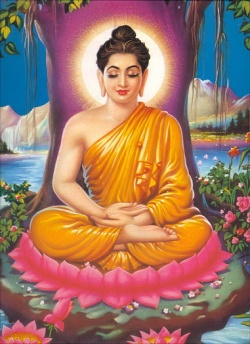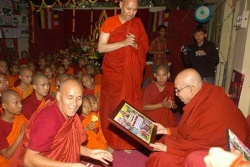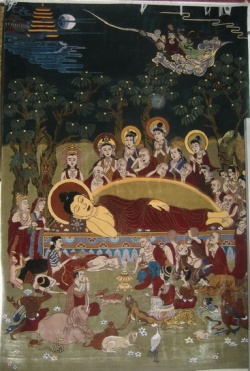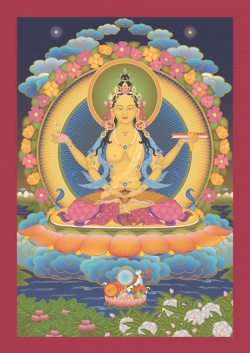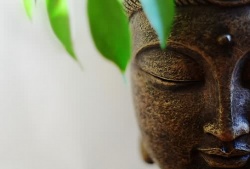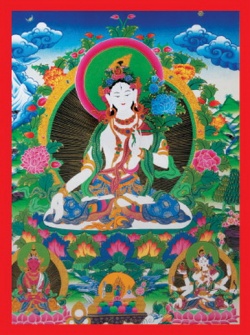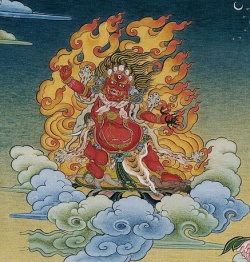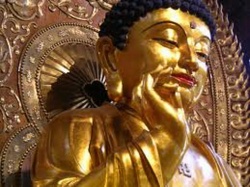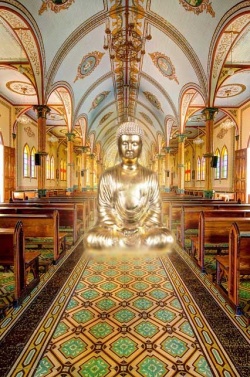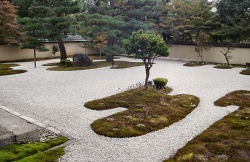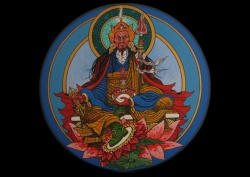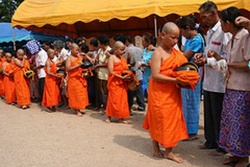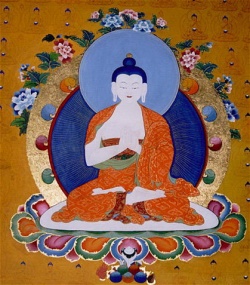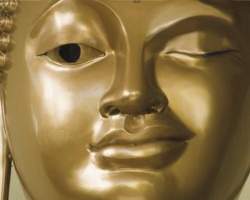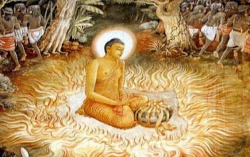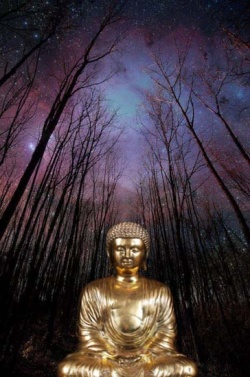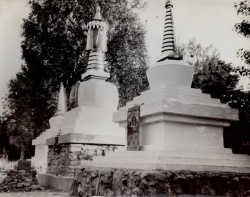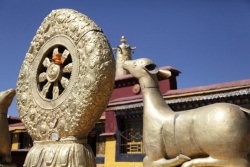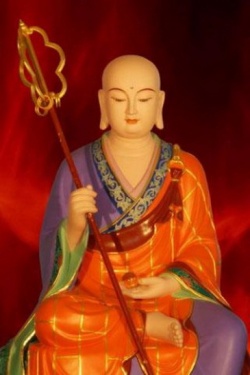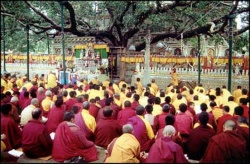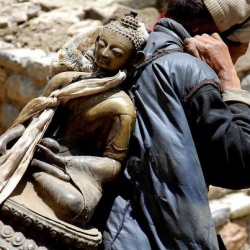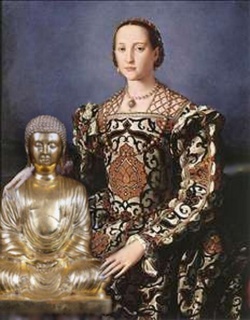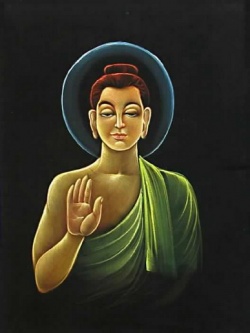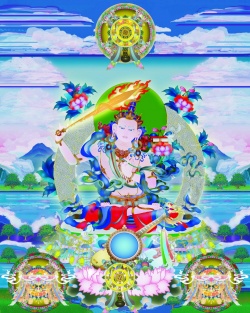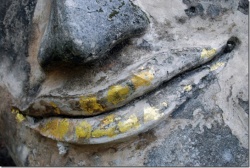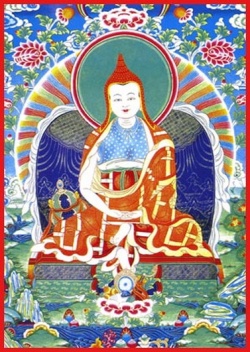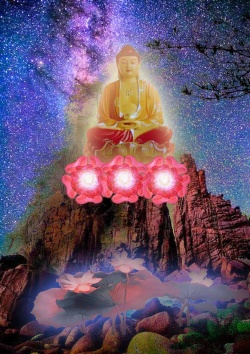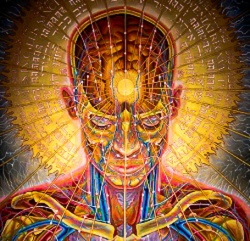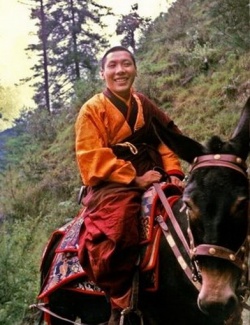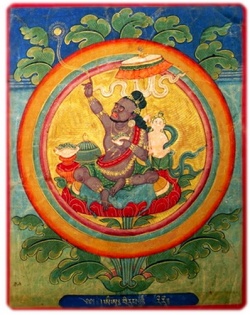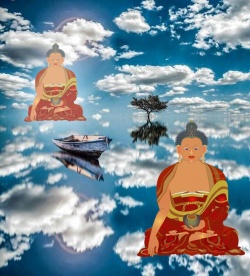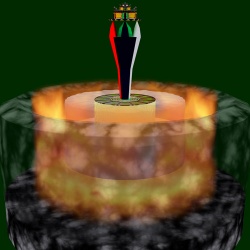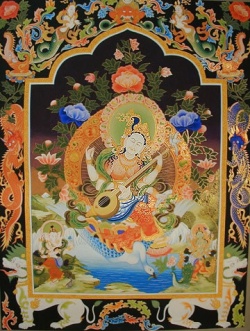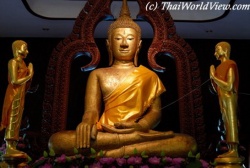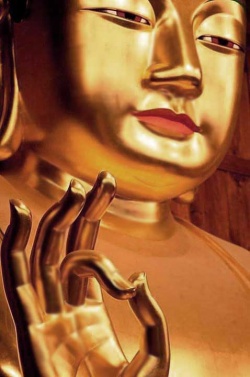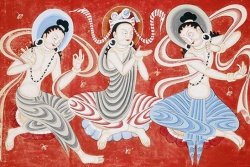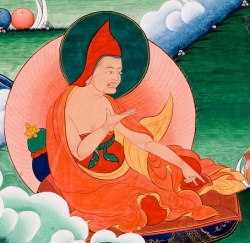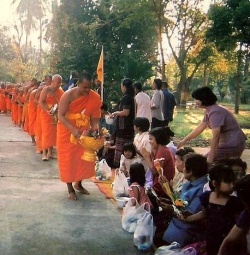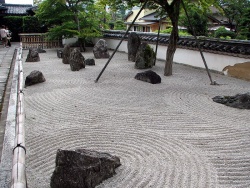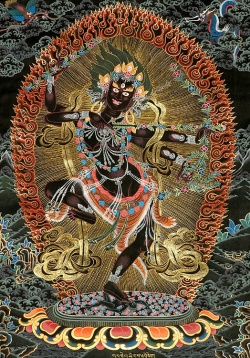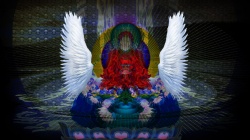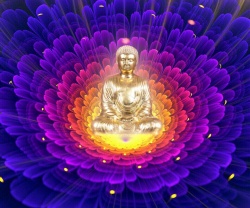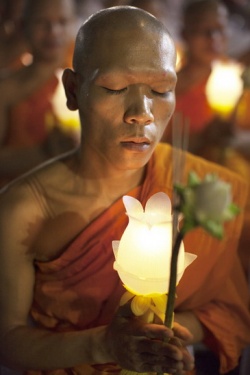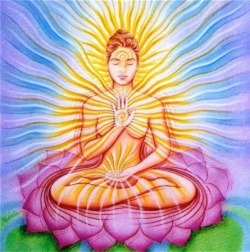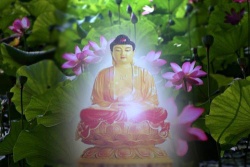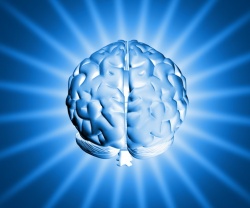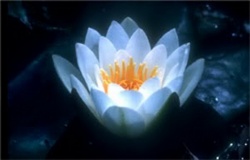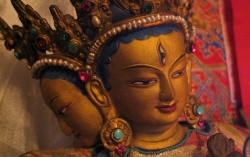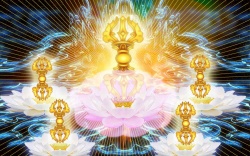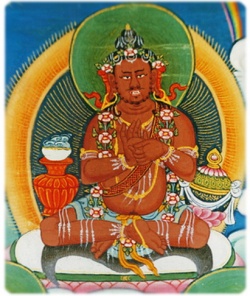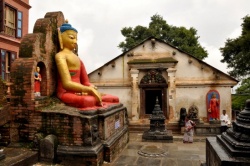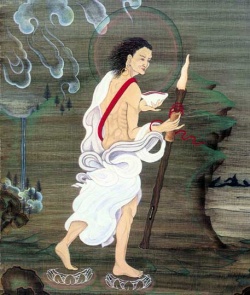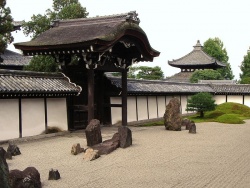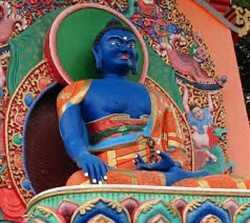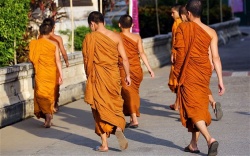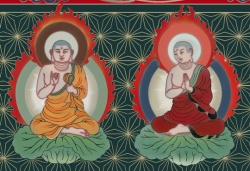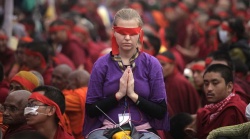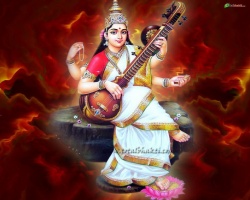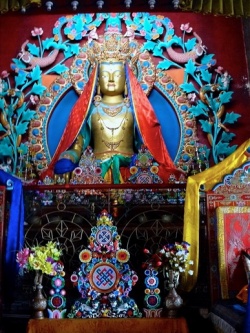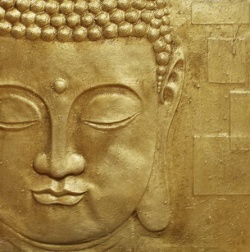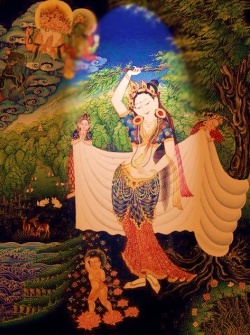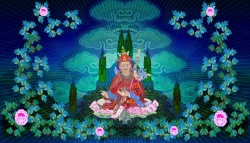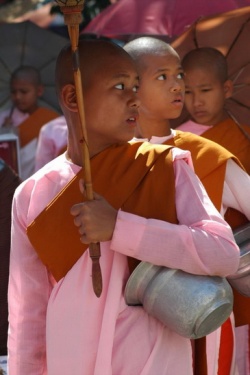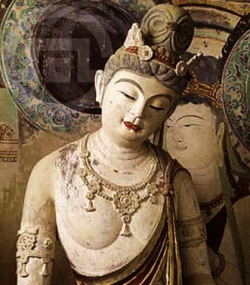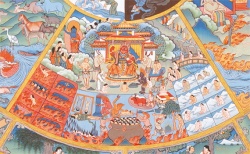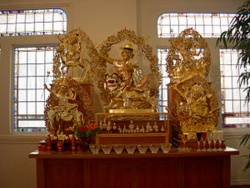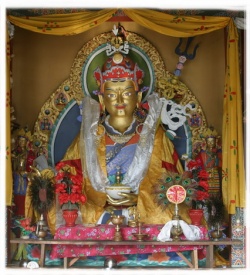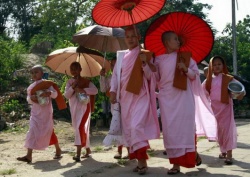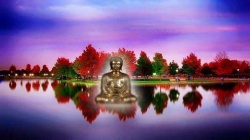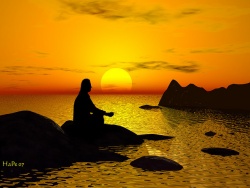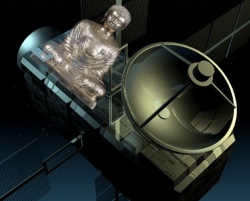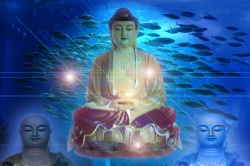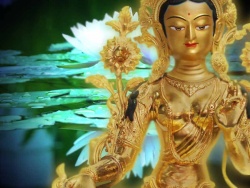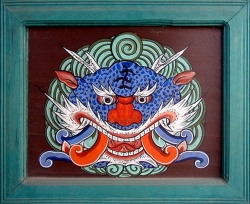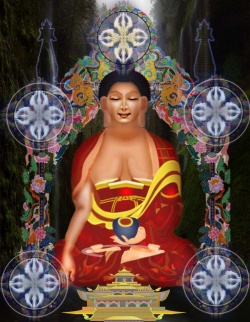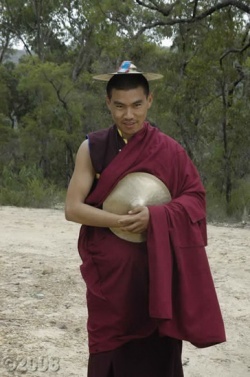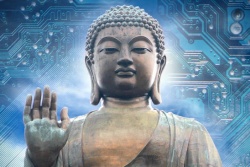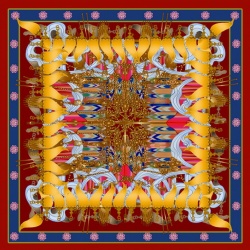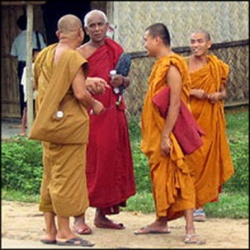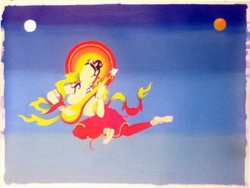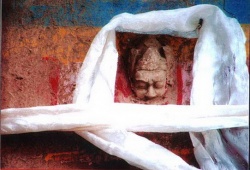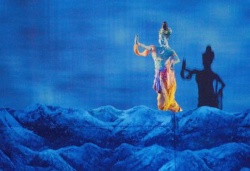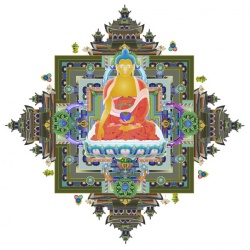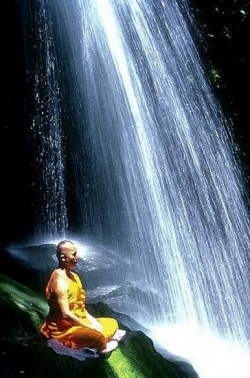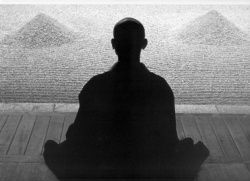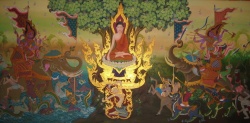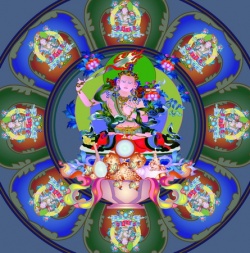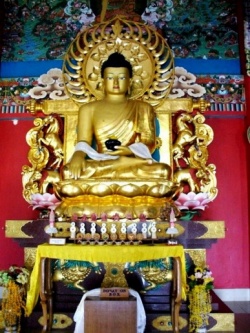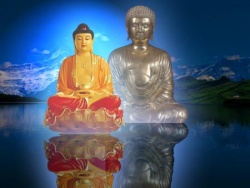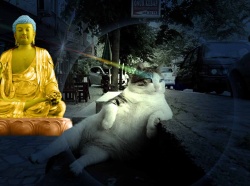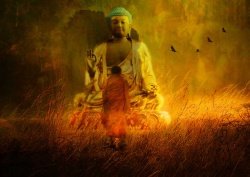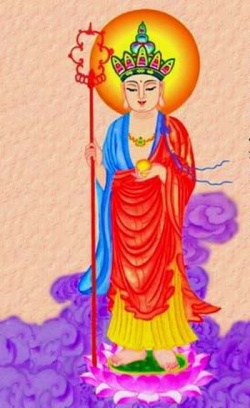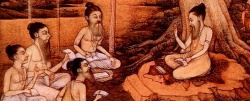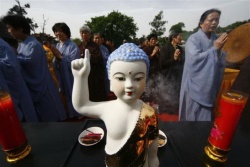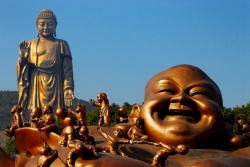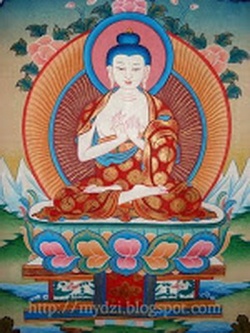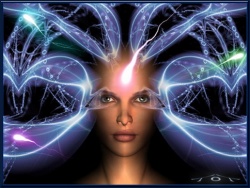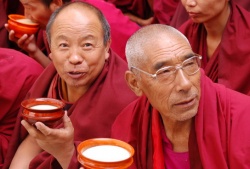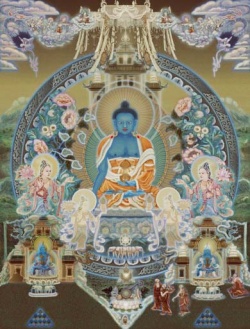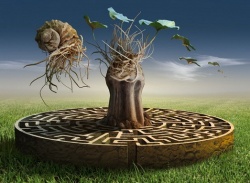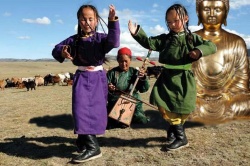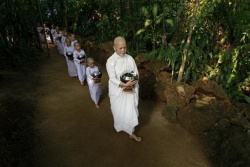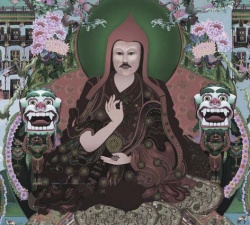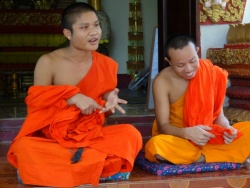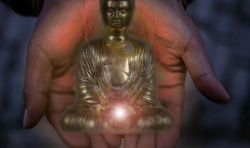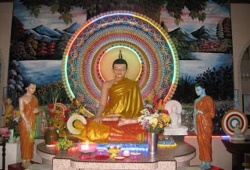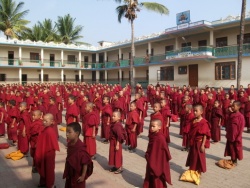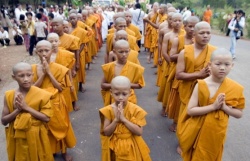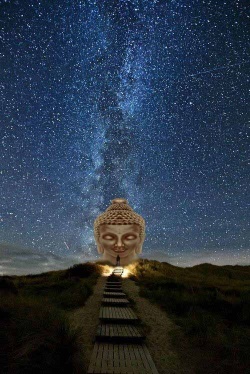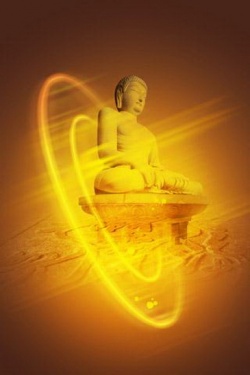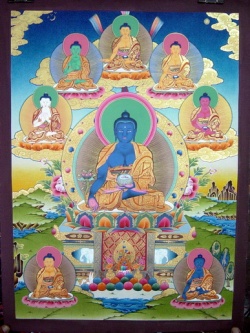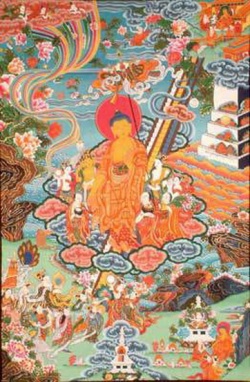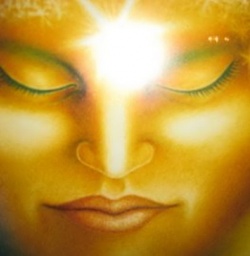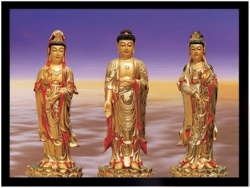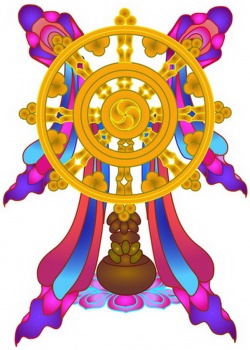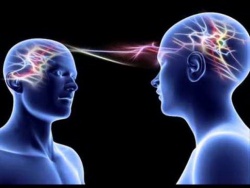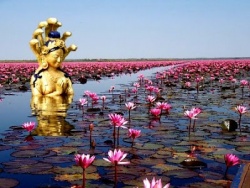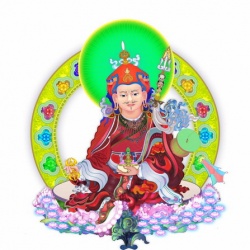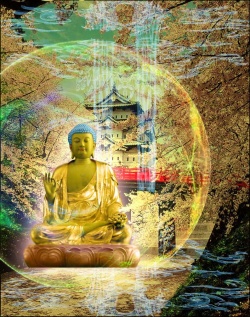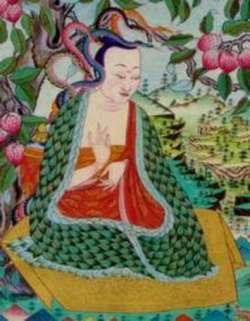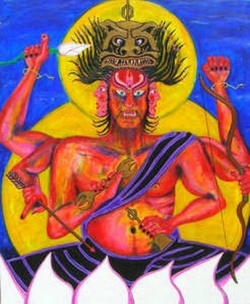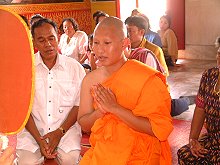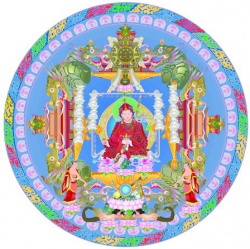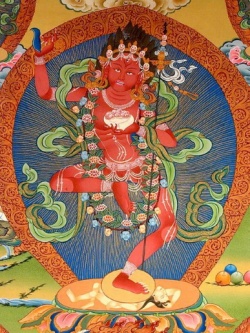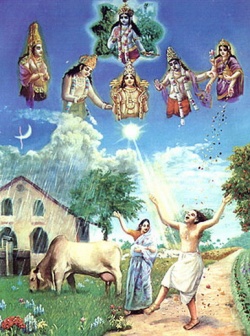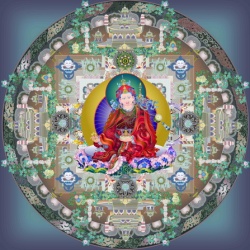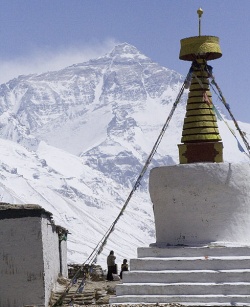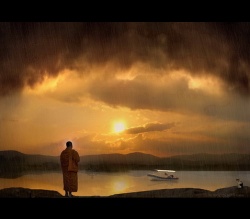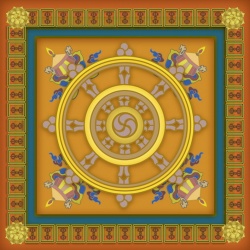Essence of Buddha Nature
Venerable Khenchen Thrangu Rinpoche
The Buddha Nature
Instructions on
A Treatise entitled: “A Teaching on the Essence of the Tathagatas (The Tathagatagarbha)”
by the Third Karmapa, Rangjung Dorje,
according to
An Illumination of the Thoughts of Rangjung (Dorje):
A Commentary to “The Treatise that Teaches the Buddha Nature”
by Jamgon Kongtrul Lodro Thaye the Great
Translated from Tibetan by Peter Roberts
Presented at the Namo Buddha Seminar in Oxford, 1990
Dedicated to the long life, good health, and beneficent activities of
His Holiness the Seventeenth Karmapa, Urgyen Trinley Dorje,
His Eminence Jamgon Kongtrul Rinpoche, Lodro Chokyi Nyima,
Venerable Khenchen Thrangu Rinpoche, all Kagyu Masters
who never tire of teaching and helping whenever called,
Peter Roberts for translating so reliably, and those
who simply care, each in his and her own way.
CONTENTS
The Root Text
Introduction
1. An Explanation of the Title
2. Why Shastras Were Written & Nine Categories of Shastras
3. Homages in Traditional Texts
4. When Did Samsara Begin? When Will It End?
5. Definitions of the Buddha Nature
6. How Does Samsara Arise?
7.Why Did Rangjung Dorje Write The Tathagatagarbhashastra?
8. Thirty-Two Unsurpassable Qualities of the Dharmakaya
9.The Wonderful Rupakayas: The Sambhogakaya, the Nirmanakaya
10.Teaching Through Example
11.Refutations and Proof
12.The Presence of Wisdom
-Discriminating Wisdom
-Wisdom that Accomplishes Actions
-Wisdom of Equality
-Lasting Wisdom
13. Eliminating Doubts of Other Viewpoints 14. Quotations that Describe Realization of the Buddha Nature 15. A Summary of the Sutras and Tantras by the Third Karmapa 16. Conclusion & Dedication
The Root Text
The Treatise entitled: “A Teaching on the Essence of the Tathagatas (The Tathagatagarbha)”
by the Third Karmapa, Rangjung Dorje
Translated by Peter Roberts
at Sonada Monastery near Darjeeling in June 1990, from a five-folio xylograph printed at Rumtek Monastery, Sikkim
Verse divisions and translation are based on Jamgon Kongrtrul Lodro Thaye’s commentary to this text, a forty-one-folio xylograph made at Rumtek Monastery, Sikkim, entitled “An Illumination to ‘The Treatise that Teaches the Buddha Nature’ –De-bzhin-gshegs-pa’i-snying-po-tsan-pa’o-bstan-bcos-kyi-rnam-‘grel-rang-byung-dgong-gsal-ces-bya-ba-bzhugs-so”
I pay homage to all the Buddhas and Bodhisattvas.
“Though beginningless, it has an end.
It is pure by nature and has the quality of permanence.
It is unseen because it is obscured by a beginningless covering.
Like, for example, a golden statue that has been obscured.”
That was taught (by the Buddha).
“The element of the beginningless time
Is the location of all phenomena.
Due to its existence, there are all beings
And also the attainment of nirvana.”
(That was taught by the Buddha.)
“All beings are Buddhas,
But obscured by incidental stains.
When those have been removed, there is Buddhahood.”
That is a quotation from a Tantra.
The “element” has no creator,
But is given this name because it retains its own characteristics.
“Beginningless” means that
There is nothing previous to it.
The “time” is that very instant.
It hasn’t come from somewhere else.
“Phenomena” are explained to be
Samsara and nirvana appearing as a duality.
This is named “the ground of the latencies of ignorance.”
The movement of mental events, correct thoughts
And incorrect thoughts are the cause of that arising (of samsara and nirvana).
The condition for their causes is taught to be the alaya (the universal ground).
The “location” is the Buddha nature.
Incorrect conceptualisation is completely located within the mind’s purity.
This purity that exists in that way
Exists, but is not seen due to ignorant conceptualisation.
Therefore, there is samsara.
If they are dispelled, there is nirvana,
Which is termed “the end.”
“Beginning” and “end” are dependent upon conceptualisation.
Mental events are like winds
That cause karma and kleshas to arise.
The (karma and kleshas) manifest the skandhas, dhatus,
Ayatanas, and all the phenomena of dualistic appearances.
Someone who strives for and discards these (appearances) is deluded.
What can be negated through rejecting your own projections?
What can be gained by acquiring your own projections?
Isn’t this belief in duality a fraud?
Though this understanding is taught as a remedy,
The understanding of non-duality is not truth.
It is not conception of non-conceptuality.
The understanding of emptiness gained through breaking down forms and so on,
Isn’t it itself a delusion?
But it is taught so that attachment to things as real will cease.
There isn’t anything that is either real or false.
The wise have said that everything is like the moon’s reflection on water.
The “ordinary mind” is called
The “dharmadhatu” and “the Buddha nature.”
The enlightened cannot improve it.
Unenlightened beings cannot corrupt it.
It is described by many names,
But its meaning cannot be known through verbal expression.
It is unceasing manifestation.
(It is taught) to have sixty-four qualities.
Though this is (just) a simplified description,
It is said that each of the sixty-four has millions (of qualities).
There are ten strengths
(1) the knowledge of appropriate and inappropriate actions; (2) the knowledge of the ripening of karma, (3) of natures, (4) aptitudes, and (5) aspirations; (6) the knowledge of the destinations of all paths, (7) (the possession) of dhyana; (8) divine sight, (9) the memory of previous lives, and (10) peace.
Due to those (ten strengths), there are the four fearlessnesses
(1) teaching that one abides in enlightenment, within all phenomena, (2) teaching the path, (3) teaching cessation, and (4) being beyond dispute.
Due to those causes there are these eighteen distinct qualities)
(1) no error, (2) no empty chatter, (3) no forgetfulness, (4) continuous meditation, (5) the absence of a variety of identifications, (6) the absence of an undiscriminating neutrality, (7) the possession of an undeteriorating aspiration, (8) diligence, (9) mindfulness, (10) samadhi, (11) prajna, (12) the wisdom that sees complete liberation, (13)-(15) every action being preceded by wisdom, and (16)-(18) time being unable to obscure.
If those thirty-two (qualities) are possessed, there is the dharmakaya.
In our present (state), we deny the (presence of the Buddha nature) and these qualities.
There is no understanding of it as it is.
The non-existent “fabrications” are conceived of as existent.
The “completely true” is not known.
Thus we create our own torment.
Oh! Understanding these qualities of the dharmakaya
To be true is the knowledge of truth,
But in their present state, beings with meagre ability
Reject the knowledge of truth and fabricate untruth,
Which is adopted by the agitation that follows it.
Through knowing (the Buddha nature) as it is
One obtains its powers.
There is nothing whatever to be removed;
There isn’t the slightest thing that needs to be added.
The truth is truly seen.
If the truth is seen, there is complete liberation.
The “element” is devoid of the incidental impurities,
Which have the characteristic of being separate.
It is not devoid of the unsurpassable qualities,
Which have the characteristic of inseparability.
In (the Buddha nature) are the qualities of the two form kayas:
The thirty-two major and (eighty) secondary signs.
Those qualities that are attained are one’s own body.
The body is not created by self, Phwya, Shiva, Brahma, external real particles,
Or by elements beyond experience.
When the impure development of the five senses,
When the (duality) of perceiver and perceived
Is purified, the name “attainment” is given.
Therefore, the purified nadis, vayus, and bindus are the pure form kayas.
The unpurified are the impure form kayas.
For example, the qualities of an encrusted
Beryl are not evident.
When it is cleaned with yak-hair cloth and salty-water,
And cleaned with vinegar and woollen cloth,
Purified, it becomes the jewel that fulfils all needs and desires.
In the same way, for the purpose of clearing away
The three encrustations of the kleshas, knowledge, and meditation
From the aquamarine of the mind,
There is their total cessation through the paths of accumulation and juncture,
The seven impure bhumis and their pure bhumis.
When incorrect conceptualisation
Encounters correct conceptualisation,
Just as both (kindling-) sticks are burned by the fire, there is freedom from (both) conceptualisations.
There is freedom from the concepts of elimination,
Remedies, suchness, and the idea of a result.
At that time, the flowers of the physical signs blossom
In the one who has the body of space.
The three phases of impurity, both purity and impurity,
And of complete purity are respectively:
(The phases) of beings, Bodhisattvas, and the Tathagatas.
Though this is what is said, Buddhahood is not newly created.
As it was before, it is the same after.
It is the changeless Buddha nature.
The “change” is becoming free of the stains.
If someone has the negative view
That the Buddha qualities have no cause,
Or conceive them not to be within oneself,
But created by external causes and conditions,
What difference is there between that and the eternalist and nihilist views of non-Buddhists?
The apparent momentary birth and cessation of the “mental events” (of Buddhas)
Correspond to the impure mental events (of beings).
If (the mental events of the Buddhas) were not like that,
The activity of the form kayas would cease.
However, they are not given the name “mental events,”
But (the name) “discriminating wisdom.”
The nature of material elements
Is (either) accompanied by clinging (or) their powerful essence is manifested.
There is no difference whatsoever in appearances
To the deluded and the undeluded.
The (only) difference is the presence or absence of clinging to dualism.
If that was not so,
How could the Buddhas apply their activity?
The examples of the wish-fulfilling jewel and so on
Are explained to represent the manifestation of non-conceptual power.
However, this does not exist solely within the beings of others.
If that were so, it would be the wisdom of other beings.
And if that were so, then wisdom would be delusion.
If one states that (wisdom) has attachment for its own appearances,
Then a mirror that has appearances within it
Would (also) have thoughts of attachment.
All the delusions that beings have
Appear to (a Buddha’s) wisdom.
The wisdom is however unstained by the delusions.
For example, though the material elements
Appear to originate and cease within space,
Space is unstained, is without any origin or cessation.
In that same way, though the wisdom of the Buddhas
Enters beings, it is not stained.
It is not given the name “delusion.”
It is called “(the wisdom of) accomplishment of action.”
The mind that has the absence of the three obscurations
Is “(the wisdom of) equality” and it is “peace.”
Due to having love and great compassion (for beings)
The sambhoga(kaya), etc., appears to them.
This is stated in order to refute those who say
That the attainment of Buddhahood is the same as the Hinayana (attainment).
Wisdom is the three permanences:
Permanence of nature is the dharmakaya;
Permanence of continuity is the sambhogakaya;
Uninterruptedness is the nirmanakaya.
There are three impermanences:
Mentally fabricated emptiness is impermanent;
The mind of moving thoughts is impermanent;
The composite six consciousnesses are impermanent.
However, the three permanences are present.
The three impermanences are stains.
The three permanences are wisdom.
This is not the same as the Tirthika “self,”
Because that is a mental fabrication and (Buddha nature) is not.
This is not the same as the nirvana of the Shravakas and Pratyekabuddhas
Because (in that) all the qualities of the form kayas are not manifested.
This is not the same as the body of an (ordinary) being
Because it is not created due to the defilements.
It will not change back to the previous state
Because it has manifested exactly as it is.
There will never (again) be the appearance of the stains
Because there is freedom from differentiating conceptualisation.
Therefore, the mind, this Buddha,
Is present now, but is not known.
(From the “Sutralankara”):
“When there is realization, at that time,
Just as when the heat of metal ceases,
And conjunctivitis in the eyes cease,
Because Buddhahood (has occurred), one cannot say that
Mind and wisdom either exist or do not exist.”
(From the “Mahayanavimshika”):
“Because in the pristine meaning there is no birth,
There is also no liberation there.
Buddhahood is like space.
It has the same qualities as beings.
As ‘this side’ and ‘the opposite side’ are birthless,
The composites are truly empty.
This is the experience of omniscient wisdom.”
(From the “Uttaratantra”)
“It is subtle, so it is not the object of learning.
It is ultimate, so it is not the object of contemplation.
The dharmata is profound, so it is not the object of
Mundane meditation, and so on.”
This experience of wisdom that knows itself,
This ultimate arises through trust in self-origination.
Oh! Because they do not understand this,
The children wander in the ocean of samsara!
Through the power of great Shakyamuni,
Of Manjushri, Maitreya, and Avalokiteshvara,
This was written by Rangjung Dorje.
May all beings have unmistaken knowledge
And full attainment of the Buddha nature!
This completes the definitive presentation of the Buddha nature,
which is the essence of the vajrayana.
SHUBHAM! (Auspiciousness!)
Introduction
In a prophecy, Naropa told Marpa that in his Lineage the pupils would be greater than their teachers.
The First Karmapa was Dusum Khyenpa and the Second Karmapa was Karma Pakshi, who had greater power and more miraculous abilities than the First.
Basically, both the First and Second Karmapas were in essence the same, but it appeared as though Karma Pakshi was more magnificent.
In the same way, the Third Karmapa, Rangjung Dorje, had even greater qualities of learning and miraculous abilities. There are seventeen Karmapas and among them Rangjung Dorje was the greatest scholar.
In fact, two Karmapas showed immense learning, experience, and realization; they were Rangjung Dorje, the Third Karmapa, and Mikyo Dorje, the Eighth Karmapa.
Mikyo Dorje demonstrated great knowledge and realization of the sutras, and Rangjung Dorje demonstrated great knowledge and realization of the tantras.
Rangjung Dorje was a master of the Kalachakra teachings.
He had the experience, realization, and clear knowledge of the movements within the body, of the nadis (“the channels”), the vayus (“the subtle winds”), and the bindus (“the subtle essences”).
He understood them quite clearly as they are taught in the tantras and composed the text, The Deep Inner Meaning - Zabmo-Nangdon.
Here he described all the highest tantras, the Anutaratantras, which are comprised of the father, the mother, and the non-dual tantras.
Since Rangjung Dorje had mastered the Kalachakratantra, he understood astrology and therefore the movements of the sun, moon, and stars on the basis of his knowledge of the nadis, vayus, and bindus within the body.
He therefore composed astrological texts based upon the Kalachakratantra, which clearly explained the movements of celestial constellations.
These texts are exceptional because they illuminate the movements of the planets, solar system, lunar eclipses, etc.
Rangjung Dorje wrote two treatises, which are branches of the Zabmo-Nangdon.
These two shastras are Transcending Ego: Distinguishing Consciousness from Wisdom and The Teaching on the Tathagatagarbha, the text presented here.
In the first shastra, the Glorious Third Karmapa showed the difference between the various types of consciousness and wisdoms; in the latter he showed how the Buddha nature is present within all living beings.
1. An Explanation of the Title
All living beings born in the world see it as their birthright and duty to experience happiness.
But they experience the suffering of ageing, sickness, and death.
Alternating between surprise and disappointment, the only liberation from anxieties arising from dual experiences that burn continuously is recognizing and removing own imperfections and evolving instead of remaining self-involved.
His Holiness the Third Karmapa, Rangjung Dorje, therefore wrote
The Treatise entitled: “A Teaching on the Essence of the Tathagatas (The Tathagatagarbha)”
Let us look at the Sanskrit word tathagatagarbha, which is de-dzhin-gshegs-pa’i snying-po in Tibetan, to understand well what letting go in order to release the true nature means, which is the goal.
The Sanskrit means “the womb,” garbha from the root word garbh, “to conceive” (which in pure Sanskrit can also mean “the interior, embryo, foetus”) of the Tathagatas, i.e., “the place from which they are born.”
Tathagata is comprised first of the syllable tatha, which means “in that manner, in that way, so, thus.”
The second half of the word has been interpreted to be both gata, “gone,” and agata, “come,” as the same result comes from the combination of tatha with either word.
However, gata as the conclusion of the compound word normally has the meaning of “to be” something or somewhere, so that the term would mean “one is thus” or “like that.”
Therefore, although the Sanskrit can mean, “to be in such (a state or condition),” it has been glossed and translated literally as “one who has come and/or gone like (the previous Buddhas),” i.e., a Buddha.
The Chinese translation of the term tatha followed the interpretation “one come in that way,” while the Tibetan de-bzhin-gshegs-pa followed “one gone in that way.”
The word garbha was translated into Tibetan as snyging-po, which means “essence,” so that the Tibetan term literally means “the essence of the Tathagatas” instead of “the womb or embryo of the Tathagatas.”
The Standard English translation of either the Sanskrit or Tibetan is “Buddha nature.”
The Third Karmapa wrote the treatise that explains the Buddha nature so that disciples and pupils let go of the sense of being separated from the external world and give rise to and manifest kindness and goodness instead.
Rangjung Dorje taught about the essence of the Tathagatas, one could also say Sugatas and called the treatise The Sugatagarbhashastra.
Sugata means “gone to bliss.” In order to win the peace of bliss, it is necessary to follow in the footsteps of the Buddhas and Bodhisattvas.
In this regard, a spiritual teacher who has attained wisdom and bliss can - through setting examples, presenting instructions, and offering guidance - show the way.
Can ordinary beings reach the same goal the Buddhas have attained?
Just as the Buddhas and Sugatas tread the path and have gone to bliss, every living being can because the Buddha nature is innately ours.
The term Sugata refers to bliss, which, in turn, points to suffering and pain.
The term Tathagata, in contrast, means “one gone like that” or “one gone thus.”
This means that when a Bodhisattva has realized Buddhahood, he or she has not only gone to bliss but has naturally manifested his or her true nature - bountiful virtues and values of lasting worth.
All living beings possess the Buddha nature, the pure essence.
Everyone can attain a state of bliss that opens and yields ineffable qualities. How? By meditating.
There are the Dzogchen and Mahamudra meditation instructions in the Buddhist Tradition.
One needs to receive these instructions from an authentic spiritual master and guide, someone who can reliably show the way.
If one receives meditation instructions, understands them perfectly, and knows how to practice, then no difficulties will arise.
If one does not understand the instructions clearly, then practice will be very difficult.
This is the reason why the instructions on the Buddha nature were given.
In the commentary to this text, Jamgon Kongtrul Lodro Thaye the Great stressed the importance of knowing why one engages in meditation practice.
The reasons are presented in the teachings on the view, which is won by studying the texts.
He stressed the significance of practicing meditation with the correct view, otherwise one would resemble someone who tries to climb a steep mountain cliff without any hands.
Similarly, he compared someone who has won certainty of the view but does not meditate with a rich person who hoards his wealth out of miserliness.
Jamgon Kongtrul Lodro Thaye wrote that if one practices both disciplines, namely gains certainty of the view by studying the instructions and meditates properly, then a disciple resembles a bird flying through the sky with two wings fully in tact.
He tells us that the right wing of the bird is meditation, the left wing is knowledge, and when both wings are healthy the bird can fly freely.
This is the reason why the Third Karmapa wrote the treatise on the Buddha nature, so that living beings are inspired to attain unity with their own brilliant treasure, ever present and true.
Why Shastras Were Written & Nine Categories of Shastras
In general, the discourses presented by Lord Buddha are collected in the Kangyur, “The Translation of the Buddha’s Word,” or sutras (Sanskrit for the Pali word sutta, “scripture”).
The three traditions of Buddhist scriptures are the Theravada, the Chinese, and the Tibetan.
In particular, the Chinese masters emphasized the sutras and criticized the shastras (bstan-bcos in Tibetan), the “written commentaries” by Buddhist masters that are collected in the Tangyur, “The Translations of Teachings”; they said that they are not valid.
The Vajrayana masters of Tibet always recognized and honoured the importance of the shastras because the scholars who composed them did not write something different than Lord Buddha’s words.
The Tibetan version of the Tangyur consists of more than 100 volumes.
The vast collections of scriptures are named after the place where they were printed and published.
The complete Kangyur was first published in Beijing in 1411, the first Tibetan edition was printed at Narthang in 1742 and consists of 98 volumes.
The Narthang Tangyur contains more than 3.600 texts with stories, commentaries on the tantras and sutras, discussions on Vinaya and Abhidharma, logic, rhetoric, grammar, literature, biographies, painting, medicine, chemistry, and astrology.
The Derge Kangyur was edited by Situ Panchen Chokyi Jungney and was completed in 1744 by Tsultrim Rinchen.
The Derge Collection was printed at both the Printing Academy and Palpung Monastery in Derge, West Sichuan, the latter treasured in most monasteries, hermitages, and temples in Tibet and Mongolia the most.
It was because of these collections of Buddhist wisdom that the Mahayana tradition survived through many centuries, from the time that the translations began in the 8th century until now.
Why were the shastras written?
One reason why the shastras that are collected in the Tangyur were written is because the Buddha’s teachings are so vast and a beginner would find it very tedious to gain an understanding of a specific topic from the original texts collected in the Kangyur, which are not organized in an accessible way.
The Buddha replied to individuals who asked questions in different places and under other circumstances, therefore the teachings are answers to specific questions.
Pupils living somewhere else asked other questions and received different answers.
The vast amount of teachings are therefore scattered throughout the sutras and not organized according to topics in a single volume, so it is not possible for us to learn what we wish to know from the many sutras.
This is the reason why great masters composed treatises in which they collected and compiled a subject matter from the various sources into one text.
A shastra deals with one subject found in many sutras.
This is one reason why the shastras are important and precious - a topic is accessible.
Furthermore, shastras clearly explain profound subjects.
Some pupils think that only knowing what the Buddha said suffices and have deep faith, while other pupils are more inquisitive.
For example, in The Prajnaparamitasutra we read,
There are no eyes, no ears, no tongue (…).
Some students have conviction in this statement and rely upon the Buddha’s words. Others wonder and seek explanations from qualified teachers.
Scholars wrote texts to explain the meaning and logically prove why such statements are true.
Another reason why shastras were written was to hinder a decline and distortion of the precious teachings.
Some sutras may be lost or not translated into Tibetan; other sutras only contain certain answers to specific questions.
In order to prevent degeneration of the Buddha’s words, a great master wrote a treatise in which the entire subject would be covered.
These are three reasons why Rangjung Dorje and other great masters wrote shastras.
There are many different kinds of shastras. Jamgon Kongtrul Lodro Thaye the Great defined nine categories:
(1) Meaningless shastras are texts that, for example, go into detail to argue whether birds have teeth or not. Such literature is of no help to anyone and does not encourage spiritual practice. Studying them is of no help or benefit to anyone.
(2) Incorrect shastras convey wrong meanings.
For instance, there are texts that try to explain that if one dies in a war, one will attain liberation, but dying in anger and rage that every war always entails is of no benefit to anyone at all.
(3) Meaningful shastras convey beneficial thoughts.
Studying this type of treatise will definitely be good for oneself.
(4) Deceptive shastras mislead people.
There was once a king in ancient India who had a beautiful daughter he wished to see married, so he wrote a text in which he said that things happen for no reason at all and haphazardly.
He argued that peas are round and thorns are sharp without a cause, implying that even though his daughter grew up in a hothouse atmosphere, there would be no reason to worry about marrying her.
(5) Heartless shastras are texts that have no compassionate message. Once I came across a group of Hindu ascetics at the Marataka Caves who were sitting around a burning log and inhaling the smoke.
I asked them why they were doing this, and they answered that they were practising asceticism as they had read. Now, a teaching of this kind only causes suffering for such practitioners and does not help anyone at all.
(6) A shastra that instructs how to eliminate suffering is a treatise that shows how to become free from the temporary suffering of conditioned existence and how to achieve lasting freedom from discomfort and discontent.
(7) A shastra devoted to learning is a treatise that helps gain an understanding of a subject matter.
(8) A shastra dealing with debate is a treatise that teaches how to discuss various opinions through refutations and proof.
(9) A shastra devoted to spiritual practice is a treatise that brings lasting benefit. Shastras seven and eight offer temporary well-being, while number nine teaches how to practise so that one gains reliable, beneficial results.
There are six types of shastras that one does not need: 1, 2, 4, 5, 7, and 8.
One needs the treatises that have a meaning, that show how to eradicate suffering, and that are devoted to helping us practice: numbers 3, 6, and 9.
The tradition of writing shastras originated in India, where scholars would compile and comment specific subjects presented in the sutras.
In Tibet, another tradition arose and developed. Masters would commence a commentary by first composing an outline of the entire text they were presenting.
Their treatises begin with a short summary, and then they wrote a detailed explanation.
This approach makes it easier for the teacher and for students. It is difficult understanding an outline which summarizes an entire text, often referred to as “root texts,” and that is also why shastras were written.
3. Homages in Traditional Texts
In the Buddhist tradition it is the custom when writing a treatise to begin with the name of the treatise, then to pay homage, and often to pledge to write the treatise.
This is done so that the author doesn’t encounter any obstacles while writing a book and so that the text presenting the Buddha’s words benefits others in the future without any hindrances.
The supplication is written with the wish that when it is finished and others study, contemplate, and meditate, they will encounter no obstacles but will be able to master the training and practices that the author hoped to convey.
First there is homage to the Three Jewels – the Buddha as the teacher, the Dharma as the body of teachings, and the Sangha as all noble friends assisting and accompanying one along the way.
In Buddhism, it is recognized that a Buddha is someone who has achieved the state of realization through having gradually proceeded on the successive stages of the path.
While on the stages of the path he or she is a Bodhisattva.
Therefore, there is the homage to the Buddhas who have completed and to the Bodhisattvas who are on the path.
The homage in the Sutra Tradition that Noble Rangjung wrote to commence The Tathagatagarbhashastra reads,
I pay homage to all Buddhas and Bodhisattvas.
The homage that Shantideva wrote in The Bodhicharyavatara is,
“To those who go in bliss, the Dharma they have mastered and to all their heirs,
To all who merit veneration, I bow down.
According to tradition, I shall now in brief describe
The entrance to the bodhisattva discipline.”
(Shantideva, The Way of the Bodhisattva. A Translation of the Bodhicharyavatara.
Translated from the Tibetan by the Padmakara Translation Group, Shambhala, Boston & London, 2002, page 33.)
A few verses from Shantideva’s sincere offerings are,
“To the buddhas, those thus gone,
And to the sacred Law, immaculate, supreme, and rare,
And to the Buddha’s offspring, oceans of good qualities,
That I might gain this precious attitude, I make a perfect offering.
I offer every fruit and flower
And every kind of healing medicine;
And all the precious things the world affords,
With all pure waters of refreshment;
Every mountain, rich and filled with jewels;
All sweet and lonely forest groves;
The trees of heaven, garlanded with blossom,
And branches heavy, laden with their fruit.”
(Ibid., page 29.)
When paying homage, there is the understanding that the Buddha has two qualities.
These two qualities address the two sides of existence, being and becoming.
The first side points to the fact that ordinary living beings have the three negative kleshas (Sanskrit for “mind poisons”), which are ignorance, aggression, and desire.
The second aspect is that ordinary living beings possess the pure qualities of knowledge and love for others, small in comparison to the mind poisons.
The positive qualities gradually manifest when a practitioner relies on the remedies to decrease and eradicate the kleshas the moment they arise or before they grow.
When the negative kleshas have been eliminated, then there is attainment of Buddhahood, the state of a perfect Buddha, which is enlightenment.
The Tibetan word for “cleansed” is sang, the first half of the name for Buddha.
When all faults have been removed, then the positive qualities manifest; they are wisdom, love, and great compassion for all living beings.
Love and compassion encourage and empower.
All qualities of being and becoming develop and increase through the cleansing process of practice.
The Tibetan word for “developing and increasing” is gyae, the second half of the word for Buddha in Tibetan, Sang-gyae.
That is why Sanggyae, “Buddha,” embodies the purification of all negative tendencies and habits as well as the attainment of all beneficial qualities, which are then “vast,” gyae in Tibetan.
Paying homage to Buddha is honouring and revering the result of the path, the supreme state of perfection, which is enlightenment.
There is also the homage to the Bodhisattvas who are on the path, i.e., those progressing from the state of an ordinary being to that of perfection. Bodhisattvas have three qualities, as the connotation shows.
The Tibetan term for the Sanskrit word bodhi has two syllables, chang and chub.
These two syllables mean, respectively, “cleansed” and “attained.”
Just as the word sang in the Tibetan name for Buddha, Sanggyae, cleansed means purified of the negative kleshas described above.
A Bodhisattva has not cleansed all kleshas yet since he or she is still on the path, but gradually eliminates more and more while practicing the skilful methods of the path.
The second Tibetan syllable for the Sanskrit word bodhi is chub, which means, “to obtain (the positive qualities).”
A Bodhisattva unfolds more and more qualities of being while he practices the stages of the path.
In this way, a Bodhisattva develops qualities of purification as well as attainment.
The Tibetan word for the Sanskrit term sattva in Bodhisattva is sem-pa and means “a hero, a courageous and brave person.”
A practitioner of the Buddhadharma indeed needs courage in order to eliminate his or her own faults that are impediments to pure qualities of being.
In the beginning, a practitioner needs confidence; he or she needs to know that it is possible to remove negative kleshas and to manifest values of worth.
A student needs confidence that practicing the teachings Lord Buddha imparted will lead to the beneficial results of purification and attainment, qualities a Buddha manifests freely and openly.
A Changchubsempa, a Bodhisattva, sincerely and diligently works with and realizes these three values that beautify him or her: courage, purification, and realization, and he or she never gives up.
In the past, texts that dealt with topics from the Abhidharma or higher knowledge began with homage to the Bodhisattva Manjushri, who embodies wisdom.
The sword he carries symbolizes that he cuts the basic klesha of ignorance.
“I bow to the youthful, gentle and brilliant Manjushri.”
Texts written by Asanga in reliance upon instructions from Buddha Maitreya pay homage to the coming Buddha with the line,
“To the Guardian Maitreya we bow in supplication.”
The homage that the Third Karmapa, Rangjung Dorje, wrote in The Mahamudra Monlam Prayer begins with the Sanskrit words Namo Guru because the teachings of the Buddha and the commentaries written by scholars and Siddhas were translated from Sanskrit into Tibetan,
so it is to show that these teachings were not invented in Tibet but originated in India, the home of Lord Buddha and the great Siddhas.
“Namo Guru,
Lamas, Yidams and deities of the mandala.
Buddhas and Bodhisattvas in the ten directions and of the three times,
Please look upon me with compassion and bestow your blessings
So that my aspiration be fulfilled with your guidance.”
Namo Guru means “homage to the Guru,” “homage to the teacher.”
This is written because when one practices the Dharma, in particular meditation, one needs to rely upon a teacher for instructions.
If one meditates without a guide, the meditation may be faulty.
In the same way as one needs a guide to show the way to a place one wishes to visit, one can end up where one didn’t want to go without one.
With a guide, it is easier taking the right road and it is more likely that one will arrive at the destination one set out to reach.
It is the same with the practice of meditation.
One needs a teacher because one has no experience.
One needs someone who can instruct, “If you meditate in this way, then you will have that kind of experience, and when you have that kind of experience, this is what you should do.”
Trying to meditate without a guide may be all right but may go wrong.
Even if everything goes well, there are different ways of practicing meditation.
There might be a long way, there might be a short way, so one needs to have a teacher who has experience in meditation and who can guide one in one’s practice.
This is important for the practice of meditation in general but especially for Mahamudra and Dzogchen.
That is why The Mahamudra Prayer begins with homage to the teacher.
Furthermore, the homage to all Buddhas and Bodhisattvas is a request for their blessings, which must always be made. Some people think that they don’t need a blessing and that whatever they achieve is their own making.
But it isn’t like that. Others may think that a blessing gives them power and imparts an immediate transformation.
But it is not like that either.
One receives the blessings from the Guru in terms of positive karma, so that one will be able to gradually abandon ill will and increase the good,
or that the one will be able to diminish the kleshas in one’s mind and enhance one’s good motivation as well as one’s love and compassion for others as one has for kin.
One only gains wisdom through one’s own efforts as well as through the blessings one receives, so there is a natural dependence.
In The Mahamudra Prayer, Rangjung Dorje also supplicated the Lamas and Yidams of the Transmission Lineage who abide in the splendorous mandala.
One prays to them, too, because one has faith and wishes to receive their blessings.
It is a wish, and wishes come true if one has faith and sincerely tries.
A few lines from the homage Patrul Rinpoche wrote in The Words of My Perfect Teacher:
“Venerable teachers whose compassion is infinite and Unconditional, I prostrate myself before you all.
Conquerors of the mind lineage, Vidhyadharas of the symbol lineage
Most fortunate of ordinary beings who, Guided by the enlightened ones, have attained the twofold goal – Teachers of the three lineages, I prostrate myself before you.
In the expanse where all phenomena come to exhaustion, you
Encountered the wisdom of dharmakaya;
In the clear light of empty space you saw sambhogakaya Buddhafields appear;
To work for beings’ benefit you appeared to them in nirmanakaya form.
Omniscient Sovereign of Dharma, I prostrate myself before you.”
(Patrul Rinpoche, Kungzang Lama’ i Shelung – The Words of My Perfect Teacher, Shambhala, Boston, 1998, page 3.
What is fruition of one’s efforts?
Bringing appearances, which are generally experienced as imperfect, to a pure level.
The view won through studying the scriptures understands that anything experienced is only relative.
In truth, appearances have no real existence, are like visions in a dream.
Understanding the true essence of all things is experiencing their purity.
It is not through reciting mantras or through receiving some substance, which supposedly possesses power, that impurity is transformed.
It is through understanding that appearances themselves are not imperfect, but that clinging to things as real generates and increases the confusion and suffering that the kleshas always entail.
What are impure and pure levels of being? Although things are in the absolute sense voidness or the pure nature, on the relative level things manifest in reliance upon one another; they depend upon each other; they originate, one from the other.
Impure levels of being are perceiving and believing that things are real and exist independently, whereas the true nature of all things is emptiness.
Appearances aren’t wrong; rather one’s way of relating to them - as though they were final and real - is mistaken.
It is due to emptiness that things arise and cease again and it is due to their unimpeded self-expression that they incessantly arise.
On the relative level, things appear but in truth are not existent, i.e., have no independent reality of their own. These two aspects only contradict each other as long as the interconnected nature of all things is not understood.
As a result, one perceives appearances and experiences and hides from one’s own limitations because one cannot see that things appear while not existing independently, i.e., things seem to exist independently but don’t.
The right view attained through studying, contemplating, and meditating the Buddhadharma is realizing that relative appearances and their ultimate nature are not in opposition to each other but are the inseparability of emptiness and self-expression, i.e., appearances are empty by nature,
continuously manifest, and do so uninterruptedly, the three permanent aspects of lasting wisdom – the dharmakaya, sambhogakaya, and nirmanakaya.
When Did Samsara Begin? When Will It End?
Always and ever, because it is beginningless.
Following the homage to all the Buddhas and Bodhisattvas, Rangjung Dorje tells us in The Tathagatagarbhashastra,
“Though beginningless, it has an end.
It is pure by nature and has the quality of permanence.
It is unseen because it is obscured by a beginningless covering,
Like, for example, a golden statue that has been obscured.”
That was taught (by the Buddha).
“The element of the beginningless time
Is the location of all phenomena.
Due to its existence, there are all beings,
And also, the attainment of nirvana.”
(That was taught by the Buddha.)
“All beings are Buddhas,
But obscured by incidental stains.
When those have been removed, there is Buddhahood.”
That is a quotation from Tantra.
Some students may think that the first sentence after the homage,
Though beginningless, it has an end, is quite strange and could argue that samsara must have a beginning somewhere and at some time.
In fact, many people insist that anything and everything must have a beginning.
But this is not so. Let us look at the example of a flower.
Where did the flower originate? It came from a sprout, and the sprout grew from a seed.
Where did the seed originate?
It came from last year’s flower, and last year’s flower came from a seed that was a product of a previous year’s flower – on and on, into the past.
We clearly understand that there is no beginning and will never be found, no matter how hard people try. Similarly, the succession of lives in samsara has no beginning.
When will samsara end? Although never, Rangjung Dorje tells us, (…) it has an end.
This means that although there is no beginning, samsara has an end. How can this be?
When one attains Buddhahood through practice, then samsara ends.
Other texts say that samsara is endless.
How can that be? These statements seem to contradict each other.
What they mean is that for an individual samsara is beginningless but will eventually end. Since there are so many living beings in samsara, it is, in fact, endless.
This is the reason why samsara does end and is endless at the same time – it is endless in that there are innumerable beings in myriad worlds entrenched too deeply in samsara to even sense that it is possible to experience relief.
In the second line of the shastra, Rangjung Dorje quoted the words of the Buddha from a sutra,
“It is pure by nature, and has the quality of permanence.”
This means that the Tathagatagarbha, the Buddha nature, has two qualities.
Some people think that it is not faultless, but this is not so.
It is immaculate and has no defect whatsoever.
It is also permanent, i.e., it is continuously present, at all times, and therefore has the quality of permanence.
Four qualities of the Buddha nature have been presented: It is beginningless, ends samsara, is by nature pure, and is permanent. One may wonder why it cannot be seen.
The Karmapa tells us that “It is unseen, because it is obscured by a beginningless covering.”
That is to say, it is covered and therefore cannot be seen, the fifth characteristic of the Tathagatagarbha, which is compared to a golden statue that has been concealed.
In the Uttaratantrashastra, Maitreyanatha presented the simile of someone possessing a piece of gold that fell from his hands and was lost in the rubbish around his feet.
One day an impoverished man came along and built his shack on the mess.
He lived there, atop the lump of gold, destitute for food and clothes.
The gold could not reveal itself, and the poor man could not see it hidden in the dirt under his hut.
A clairvoyant could, and one day someone with such abilities walked by the shack.
Out of compassion, he told the beggar that he only needed to dig for the pure gold under his house and all his worries would stop.
Yet, the poor man first needed to believe what the clairvoyant had told him before he started digging for the treasure he had been living on for such a long time.
In the same way, all living beings have the Buddha nature, which - like gold - is changeless.
As long as we are in samsara, we cannot see it.
The Buddha saw the Tathagatagarbha abiding within each and every one.
Out of great compassion, he taught about the Buddha nature, showed how to reveal it through practice, and proved that no one is forced to suffer samsara’s frustrations and woe.
Yet, we need to believe and trust him; then we are free to hear, contemplate, and practice the instructions in order to realize the true nature abiding way down within.
After unearthing the gold, samsara finally ends.
The Third Karmapa, Rangjung Dorje, generously encourages us by quoting the Buddha:
“The element of the beginningless time
Is the location of all phenomena.
Due to its existence, there are all beings
And also the attainment of nirvana.”
(That was taught by the Buddha.)
He tells us that there is the element of beginningless time, the element that is the essence of the Tathagatas, and that it has been present within since time without beginning.
It is the location of all magnificent qualities, too.
It exists within all living beings, without exception, and nobody is privileged before or above anyone else.
Whoever practices the instructions that Lord Buddha gave, can attain the final result, nirvana, because
“All beings are Buddhas,
But obscured by incidental stains.
When those have been removed, there is Buddhahood.”
That is a quotation from Tantra.
Rangjung Dorje is sharing a quotation from the The Hevajra Tantra with us, that all beings are Buddhas, always already, because they have the precious Buddha nature which is momentarily obscured by the kleshas, the incidental stains or negativities of the mind.
In the Madhyanathavibhanga - Distinguishing the Middle from the Extremes, Maitreyanatha gave three examples that show in which way the Buddha nature is obscured and can be purified again:
Water is by nature pure but can be polluted by soil and dirt – it can be cleansed. Gold is by nature pure but can be discoloured on the surface – it can sparkle again.
The sky is by nature pure but can be obscured by clouds – it can and will be clear again.
Nagarjuna, the extraordinary Indian master of the first century A.D. who founded the Madhyamaka School, also dealt with this topic and presented the examples of the sun and moon.
He tells us that they are by nature bright and clear but can be covered by a veil of clouds or dust or they can be concealed from our sight through eclipses.
Similarly, the Buddha nature is changeless and pure but can be obscured by the five kleshas (“the incidental stains” or “negativities of the mind”), which are summarized as five: craving, desire, maliciousness, laziness, and doubt.
These stains can be eliminated.
When the sun and moon shine brightly again, they appear naturally and need not have been created anew.
Just so in the text by Maitreyanatha, Distinguishing the Middle from the Extremes: Once the pollution, incrustations, and clouds have been removed, the natural purity of water, gold, and the sky, respectively, appear naturally.
Their purity is not created. Likewise, once the kleshas of the mind have been removed, the purity of the Buddha nature manifests freely and radiantly.
It is not created anew.
Rangjung Dorje stressed the importance of learning about the Buddha nature by offering quotations from the sutras and tantras, to enhance one’s trust and diligence towards experiencing and manifesting the true nature abiding within.
Many students tell me that they practice so hard but do not really know why.
It is important to want to practice, and that is why Lord Buddha presented the teachings on the Tathagatagarbha.
By having trust and confidence in our true nature and knowing that the experience of delusion, suffering, and pain can end, we are inspired to make friends with ourselves and others by unveiling the Buddha nature that is always and already abiding within and through us.
Definitions of the Buddha Nature
We went through the introduction to The Tathagatagarbhashastra by Rangjung Dorje in the chapter,
When Did Samsara Begin? When Will It End?
It is a summary of the quotations on the Buddha nature from the sutras and tantra and introduces the contents of the shastra that the Third Karmapa now offers in detail.
The root text lists six definitions of the Buddha nature given in the sutras.
I pay homage to all the Buddhas and Bodhisattvas.
“Though beginningless, it has an end.
It is pure by nature and has the quality of permanence.
It is unseen because it is obscured by a beginningless covering.
Like, for example, a golden statue that has been obscured.”
That was taught (by the Buddha).
“The element of the beginningless time Is the location of all phenomena.
Due to its existence, there are all beings And also the attainment of nirvana.”
(That was taught by the Buddha.)
Beginningless
“Beginningless” means that
There is nothing previous to it.
The “time” is that very instant.
It hasn’t come from somewhere else.
There is the element of beginningless time in all living beings, which is also the essence of the Tathagatas.
It is the place from which all wonderful qualities of being arise and already exists within every living being without exception.
This means that the one or other person does not have a better chance of realizing his or her own true being.
The word “beginningless” means that there is nothing previous to something, that nothing has gone before.
If there is a beginning, then there wasn’t anything before.
“Time” is therefore described as (…) that very instant, i.e., time is the present mind in this very instant.
Its essence is emptiness and its nature is clarity.
When the essence and nature have been realized, the ultimate is seen.
One then realizes that the relative arises amid the vast expanse of the ultimate.
The true nature of the mind is just that and not beyond conditioned existence.
Many texts speak about “four times.”
Four times
The first three refer to the past, present, and future, which are relative truths because they are mental constructs, i.e., they are designated by the mind.
For example, the present day is called “today,” the past day “yesterday” - a negation of the word “today” - and the coming day “tomorrow,” but there is nothing definite or conclusive about these statements other than functionality.
That is why there is beginningless-ness, the fourth dimension.
Whoever practices the teachings given by Lord Buddha can achieve that recognition, since
“All beings are Buddhas,
But obscured by incidental stains.
When those have been removed, there is Buddhahood.”
That is a quotation from Tantra.
Rangjung Dorje continued by presenting the next five definitions of the Buddha nature according to the sutras.
They are: element, phenomena, location, exists, and the end.
Element
The “element” has no creator,
But is given this name because it retains its own characteristics.
The Tibetan term for “element” here is khams, the Sanskrit word is dhatu, a term frequently used for the Buddha nature in the sutras and predates the usage of the term Tathagatagarbha.
So “element” refers to the beginningless Buddha nature, which is always and ever present within all living beings.
The definition of the term “element” in this context is therefore “the essence of the Tathagatas or Buddhas.”
Thus the essence of the Buddhas is the element possessing all the magnificent qualities and characteristics of a Buddha.
Who created it? Nobody created it because it possesses its own qualities, i.e., the Buddha nature is replete with the knowledge of a Buddha, the love of a Buddha, as well as the power and qualities of a Buddha’s body, speech, and mind.
These qualities are present within each and everyone and can manifest abundantly when obstacles have been removed.
“Phenomena” are explained to be
Samsara and nirvana appearing as a duality.
This is named “the ground of the latencies of ignorance.”
The movement of mental events, correct thoughts
And incorrect thoughts are the cause of that arising (of samsara and nirvana).
The conditions for their causes are taught to be the alaya (the universal ground).
The translation of the Sanskrit term dharma is “phenomena,” chos in Tibetan.
Two aspects of phenomena are presented in this treatise and are dealt with together: samsara and nirvana.
As long as living beings are in a state of illusion they do not recognize the true nature of their own minds and experience basic frustration of being a separate self, set apart from the world as other than the self, which is samsara.
When free from what causes that basic frustration, then they experience the state of peace and bliss, which is nirvana.
Although both samsara and nirvana abound, they have no reality.
As long as there is the delusion of samsara, there seem to be two distinct states, samsara set apart from nirvana.
The basis for experiencing separation is called the ground of the latencies of ignorance.
The sutras teach that everything is empty of inherent existence.
In the Prajnaparamitasutra, for example, we read,
There are no eyes, no nose, no tongue, (…).
In the shastras we learn through logical reasoning why all phenomena are empty of an own existence.
Great masters like Chandrakirti offered proof why nothing has an inherent existence; Nagarjuna and Shantarakshita presented further arguments why the sutras are true.
By studying their books we gain conviction and certainty in the fact that all phenomena are devoid of inherent existence.
These teachings show us that all things are empty, which is ultimate reality, and that things appear, which is relative reality.
Emptiness does not mean that phenomena are a vacuum like space or non-existent when they do appear and exist.
All things have a pure and an impure aspect, depending upon the view. The pure aspect of living beings is the Buddha nature, which is the clear and lucid power of awareness that everyone has.
It is not a blank state.
Maitreyanatha tells us in The Uttaratantrashastra that the Buddha nature is the presence of clarity and omniscience.
The Mahamudra instructions tell us that the Buddha nature is not beyond the realm of the mind that possesses awareness and conscientiousness.
If one investigates where the mind is located – whether inside or outside the body – one will never find it.
Why? Because the mind as well as outer appearances have no reality.
This does not mean to say that nothing happens or exists.
Things exist just because the mind clearly perceives, understands, cognises, and knows.
When the mind is directed outwards, appearances can be recognized and known due to the clear aspect of the mind; one does experience appearances but fails to simultaneously recognize that the mind is empty.
Mind’s essence is empty of an identity, its nature is clarity, and its aspect is unceasing.
It is due to the force of focusing on the clear and unceasing nature of the mind that its empty essence isn’t seen.
Ignoring the mind’s essence is what Rangjung Dorje referred to when he wrote about the ground of the latencies of ignorance.
There is the ground of the latencies of ignorance, the ground amid which all delusory appearances arise.
In the Kagyu Tradition, the essence of the mind that is seen through practice is called “ordinary mind,” which means that nothing needs to be changed or manipulated to realize it;
one merely looks at the mind’s true nature in order to see it.
Chogyam Trungpa Rinpoche called recognition of the true nature of the mind “t-g-s,” an abbreviation for the Tibetan term tha-mal-gyi-shes-pa, which means “ordinary mind.”
It is possible to directly see the nature of one’s own mind through the practice of Mahamudra or Dzogchen.
Without insight, there is the ground with all the latencies of ignorance.
All delusory appearances, all correct and incorrect thoughts, all conceptualisations arise within the ground.
There is a very subtle movement, referred to as “winds,” arising from conceptualising, from thinking, which Rangjung Dorje described in the lines,
The movement of mental events, correct thoughts
And incorrect thoughts are the cause of that arising (of samsara and nirvana).
Again, first there is the ground of ignorance and from that there is the subtle movement arising from conceptualisations, which in turn gives rise to the movements that stimulate the mind.
When a practitioner realizes the ground, then there is the wisdom, the power, and the great compassion of a Buddha.
As long as somebody does not recognize the ground, there is delusion and all that follows.
The ground of both delusion and liberation is called alaya, the Sanskrit term for “universal ground.”
The Tibetan translation for alaya is kun-gzhi, “basis of all.” The Third Karmapa wrote,
The conditions for their causes is taught to be the alaya (the universal ground).
In classical Sanskrit, alaya means, “home, house or abode,” as in Himalaya, “the abode of snow.”
It is from the root-word ali, “to come close to” or “to settle in.”
While in Buddhist Hybrid Sanskrit it can mean “a habitation,” this term also has the meaning of “a fundamental” or “ever-enduring basis.” The Sanskrit word therefore can also have the negative meaning of “attachment.”
Another description of the Buddha nature is “location,” the location for both samsara and nirvana.
“Location”
The “location” is the Buddha nature
Incorrect conceptualisation is completely located within the mind’s purity.
Samsaric conceptualisations arise due to a deluded state of mind, and the basis of delusion is the Buddha nature, which is also called “the essence of the Jinas.”
The Jinas are “the victorious ones.”
The Tibetan is rgyal-ba’i-snying-po, “the essence of the Jinas,” which is synonymous with de-gshegs-snying-po, “Tathagatagarbha.”
The Sanskrit equivalent would be jinagarbha.
In the chapter, When Did Samsara Begin?
When Will It End? the Third Karmapa explained that everything is located within the Tathagatagarbha.
As it is, there is the Buddha nature as well as incorrect conceptualisations.
Where is the basis for incorrect conceptualisations?
In the Buddha nature.
There is no other condition for incorrect conceptualisations than the Buddha nature.
Changcha Rilpa’i Dorje was a Gelug scholar who gave meditation instructions and spoke about the time he was sitting on his mother’s lap as a child and always looked for her elsewhere, without realizing that she was so very near.
His older brother told him, he turned around and saw her.
In the same way, we preside in the vast expanse of dharmata, the Sanskrit term for Tibetan chos-nyid, “the essence of reality, the completely pure nature that is ever present.”
But we focus our attention on appearances that arise and seek truth elsewhere, without realizing that it is ever so near.
If we look inwards, we can see it. Even while deluded or when so many thoughts dash through our mind, we are in the true nature – we cannot ever be anywhere else.
“Exists”
This purity that exists in that way
Exists, but is not seen due to ignorant conceptualisation.
The fifth description of the Buddha nature is that it exists in the present moment.
One may wonder whether it undergoes any changes or transformations.
No, it does not.
It is pure and is always immaculate, but due to the delusions arising from the ground of ignorance we are not able to see it.
The example of gold was presented earlier, i.e., although gold may be buried under the earth for thousands of years, it never undergoes a change but always remains pure.
The only reason why the gold is not seen is because the earth covers it.
Likewise, although the Buddha nature is always present, it never undergoes a change and always remains untouched.
The only reason why the true nature is not seen is because it is obscured by the thoughts arising from ignorant conceptualisation, which is the nature of samsara.
“The End”
Therefore, there is samsara.
If they (incorrect conceptualisations) are dispelled, there is nirvana,
Which is termed “the end.”
Rangjung Dorje tells us that samsara ends in the sixth definition of the Buddha nature.
When conceptualisations arising out of samsara have been dispelled, then samsara ends.
In The Jewel Ornament of Liberation, Je Gampopoa wrote that the Buddha nature is all-pervasive.
He compared it with oil concealed in a sesame seed, with butter in milk, with silver in silver-ore.
Although present, one only wins the oil by grinding the sesame seed; one only gets butter by churning milk, silver by melting ore.
In the same way, wisdom and compassion only emerge when incorrect conceptualisations have been dispelled.
As long as living beings remain ignorant of their true nature, understanding and wisdom are constrained.
When samsaric involvement is eliminated, then the Buddha nature is directly seen and limitless wisdom and compassion emerge and manifest radiantly.
This wisdom is not mixed or tainted with pride, anger, and the other kleshas. The nature of knowledge and wisdom is love and great compassion for all living beings.
Restricted love and compassion is compared to a mother who has no arms to save her child from drowning in the torrents of a river that has swept it away.
The mother would be helpless without the arms of wisdom, the child lost. The incomparable love and compassion of a wondrous Buddha are not like that.
A Buddha has abilities and strength. When the Buddha nature is directly seen and realized, then there is unrestricted, limitless wisdom, compassion, and strength - the end of samsara.
How Does Samsara Arise?
Before dealing with the invaluable qualities of the Buddha nature presented in The Tathagatagarbha, it will be necessary to continue with the text in the sequence of its presentation.
The first chapters are entitled,
Homages in the Traditional Texts,
Why Shastras Were Written & Nine Categories of Shastras,
When Will It End? and
What Are the Descriptions of the Buddha Nature?
The Third Karmapa continued the teaching by explaining how samsara arises.
He divided this chapter into three sections:
How samsara arises through incorrect thoughts, how the root of delusion arises through attachment and aversion, and the remedy.
How samsara arises through incorrect thoughts
„Beginning“ and „end“ are dependent upon conceptualisation,
Mental events that are like winds,
That cause karma and kleshas to arise.
The (karma and kleshas) manifest the skandhas, dhatus,
Ayatanas and all the phenomena of dualistic appearances.
Although there is no beginning or end to samsara, there appear to be a beginning and an end.
One is separated from the truth when one thinks that there is a beginning and an end; these delusory thoughts give rise to the ground or latencies of ignorance.
It is ignorance that stimulates and gives rise to reactions, which are like airs or winds that are very subtle.
It is due to the ground of ignorance that there is the subtle appearance of illusion concerning everything that arises, out of which the kleshas emerge.
Klesha means “pain, affliction and distress.” The Buddhist Sanskrit also means “impurity and defilements.”
The Tibetan translation nyon-mongs means “physical or mental misery, distress, and misfortune.”
As a standard term, it refers to various lists of ignorance, anger, envy, pride, craving, etc.
When the kleshas arise and reinforce the initial sensation, the chaotic forces that bring on frustration increase, too.
What is the basic illusion? Perceiving and conceiving that phenomena are separated from the self.
It is because of attachment to “a self” and misinterpretation of “others” that pride, jealousy, maliciousness, and further inadequate mental activities spring up and grow.
The process increases if it is not recognized and pacified.
Karma is accumulated in the process, both good and bad, due to mental activities that engage in trying to accomplish things to validate the insufficient feeling of “a self.”
Karma literally means “action,” though in other contexts it can also mean “duty and rite.”
The Tibetan translation is las, which means “actions.” Good karma is created through love and compassion, negative karma through ravaging emotions.
The mental activities leave an imprint in the ground consciousness, the alaya, where they are stored as latencies, which, in turn, stimulate and activate the five skandhas, the eighteen dhatus, and twelve ayatanas.
We learned that all things that appear, all phenomena, are an assembly of parts and are in truth devoid of an own identity.
Nothing whatsoever is independent and therefore nothing has an own, inherent existence; all things are “a heap” of various components and factors, are therefore not singular and, in any case, not self-existent.
There are five skandhas of being. Skandha means “the (psycho-physical) aggregates.”
In general Sanskrit this has many meanings, including “multitude, troop, aggregation, part, division, section, chapter.”
In Buddhism it refers to the five principal mental and physical constituents of a being: form, sensation, identification, mental events, and consciousness.
Form refers to any visible or tangible object.
We think such things exist independently but they don’t; everything is a collection of many factors.
The skandha of sensation refers to any mental and physical irritation or feeling.
The skandha of identification refers to perceiving and judging an irritation.
The skandha of mental activities means reacting to what was identified.
The skandha of consciousness is comprised of many factors and is explained in great detail in the book, Transcending Ego: Distinguishing Consciousness from Wisdom.
The Tibetan word for skandha is phung-po and literally means “a heap” but has the meaning of “aggregation.”
There are eighteen dhatus, “elements (of sensory perception),” khams in Tibetan, that give rise to the five skandhas.
There are the six sense consciousnesses of sight, sound, smell, taste, tactility, and mind.
These six consciousnesses arise due to the six sense faculties and the six objects that can be perceived
There are twelve ayatanas, bases of sensory perception)])
The Sanskrit means “seat, abiding, place,” etymologically closely related to alaya.
In Buddhist context, the sites, abodes, or supports of sensory experiences are the six sense faculties (the sixth being the mental faculty) and their respective six objects.
The Tibetan term is not a literal translation but is made up of the two syllables “birth” and “increase,” skye-ched, in reference to sensory experience.
The inner bases of perception arise, develop, and increase.
Relatively speaking, the external objects are perceived by the internal minds, which arise and increase upon having perceived an object fit to be perceived.
Experiencing the dual as unitary, and vice versa, depends upon the skandhas, dhatus, and ayatanas, and all experiences are said to be like dreams.
In a dream we see houses and places, we experience joy and fear, whereas those appearances - that the mind believes to be real while dreaming - do not exist.
Similarly, dual apprehension arises in the mind, whereas the Buddha nature is non-differentiate.
Logic and reasoning prove that all things arise from the mind.
Yet we assume that what appears to the mind does not arise from the mind and treasure the duality that there is something special about subjective experiences which distinguish it from objective things.
Therefore, the “self” is in conflict with “other.”
Earlier, we saw that nothing truly exists, that all things are by nature empty of inherent existence.
Let us take the hand as an example and seek its basis for imputation, its unitary reality.
It is not hard understanding that the thumb is not the hand, that the flesh and bones are not the hand either. Does a hand exist independently of its fragments and parts? No.
It is easy seeing that there is no self-existing hand, no self-existing fingers, either, and no self-existing joints that do not consist of fragmented parts, too. Yet we speak of a unitary whole as if things were singular, unique objects, independent, and free.
In the same way, no object exists other than through the mind that identifies and designates the assembly of many parts as a whole.
Therefore, all outer and inner appearances are mind, i.e., arise from the mind.
In meditation, we come to see that all external appearances are only mind.
Then we meditate on the mind’s essence by looking at its nature, eventually discovering that mind has no reality either, that it is empty of an own existence.
Following this practice, we meditate naturally present emptiness and discover that emptiness is not a void but that it is the fullness of perception that allows things to manifest and appear.
It is called “supreme, naturally present, self-liberating emptiness.”
How the root of delusion arises through attachment and aversion
Someone who strives for and discards these (appearances) is deluded.
What can be negated through rejecting your own projections?
What can be gained by acquiring your own projections?
Isn’t this belief in duality a fraud?
The glorious Third Karmapa explained how all things arise from the mind.
If this is so, then all actions arising from attachment and aversion are illusory.
Being in a state of delusion, appearances seem to be external and other than the mind.
We think some appearances and experiences are beneficial and experience others with fear.
We saw that actions arising from attachment and aversion are not only harmful but also wrong.
When we realize that everything is an appearance of the mind, then there is nothing to get rid of and nothing to be won.
The remedy
Though this understanding is taught as a remedy,
The understanding of non-duality is not truth.
It is the conception of non-conceptuality.
The understanding of emptiness gained through breaking down forms, and so on,
Isn’t it itself a delusion?
But it is taught so that attachment to things as real will cease.
It was taught that all dualistic appearances – all things perceived as “a self” and as “other than the self” – are experienced wrongly, that no appearance has a true and self-existing reality.
Thinking that their essence is empty is a thought that has no reality either, i.e., this thought is also a delusion.
Shantideva illustrated delusive thoughts: “One may dream of having a child and think it truly exists.
Should it die in the dream, one would think it is dead.
The thoughts of an existing as well as of a deceased child in a dream are both false since there never was a child.”
Likewise, thinking dualistic appearances exist is false and thinking that dualistic appearances do not exist is false, too.
Contemplating that everything has no true reality is a remedy against clinging to what seems to be a discordance between appearances and experiences.
The Tibetan text actually addresses the realization directly by using the pronoun “you”,
Aren’t you yourself a delusion?
The great sage Saraha taught that clinging to things as real is stupid, but clinging to emptiness is even more foolish.
Then why are these teachings presented? Why does The Prajnaparamitasutra teach, There are no eyes, no ears, no (…)?
Why are the instructions about the lack of independent existence taught?
To counteract clinging to what appears as other than and foreign to the self.
Rangjung Dorje explained the difference between correct and incorrect thoughts profoundly in The Tathagatagarbhashastra, showed how delusions arise, and in which way they have no reality, whereby the thought that delusions have no reality is also an illusion.
He concluded this chapter with the lines:
There isn’t anything that is either real or false.
The wise have said that everything is like the moon’s reflection on water.
Allow me to repeat that a perceiver, the act of perceiving, and a perception have no true reality but that they are not false either.
This may be very hard to understand and seem contradictory.
Therefore Rangjung Dorje shared the image of a moon’s reflection on water with us.
The reflection of the moon on the surface of a still lake is not the moon, but it would be wrong thinking that the reflection is not that of the moon.
The “ordinary mind” does not cling to or channel delusory thoughts of chaotic forces and does not need to be changed.
Instead, the wise simply rest in the mind’s true nature and leave it “just as it is,” t-g-s, “ordinary,” while it is ever so brilliant.
There isn’t anything that is either real or false. The wise have said that everything is like the moon’s reflection on water.
7. Why Did Rangjung Dorje Write The Tathagatagarbhashastra?
The last section was a general introduction to the Buddha nature. Rangjung Dorje continued by presenting detailed descriptions.
The “ordinary mind” is called
The dharmadhatu and the Buddha nature.
The enlightened cannot improve it.
Unenlightened beings cannot corrupt it.
It is described by many names,
But its meaning cannot be known through verbal expression.
The ordinary mind has many names.
It is called dharmadhatu when the appearances of its empty essence are meant.
It is called the essence of the Sugatas, the Buddha nature, Tathagatagarbha when its clear and all-knowing brilliance is meant.
Dharmadhatu is a Sanskrit term, the Tibetan is chos-kyi-dbyings.
Dharma means, “to hold,” “something held and prevented from falling.”
The Tibetan equivalent, chos, has the connotation “to correct,” “to remedy,” “to alter,” which means that one corrects something by removing imperfections and by developing values of worth.
Is an elimination of imperfections and a development of qualities possible? Yes.
Dhatu means “space” and refers to “the expanse of space.”
It is truly possible to do so many things in the vast expanse of space; we can stand, walk, or fly.
Everything we are able to do would not be possible without all-inclusive space - dharmadhatu, the vast expanse that does not impede the elimination of shortcomings and the development of worth.
The ordinary mind can work on eliminating faults and on developing positive qualities and that is why it is called dharmadhatu, “the realm of dharmas, existents/phenomena” or “the realm of the truth, the Buddha’s teachings.”
The term Tathagatagarbha, “the Buddha nature,” “the essence of the Tathagatas,” “the essence of the Jinas” also defines the ordinary mind.
Jina means “victorious one,” “a victor,” i.e., one is victorious over anything that harms and one is a victor over any source of negativity and pain.
It is the ordinary mind that can remove imperfections and that can develop positive qualities.
Many other names are synonymous with the Mahamudra connotation “ordinary mind.” Dharmakaya refers to the experience of great bliss when suffering has been overcome and prajnaparamita when confusion has been transcended.
Although there are many names, they all define the Buddha nature.
Lord Buddha described the true nature of the mind by using many other terms, for example, ultimate wisdom. Although there are many names that describe the Buddha nature, it is ineffable.
But when speaking about it, nobody can say that it exists or that it does not exist since it cannot be identified or designated in words.
How can this be? It is beyond thought, beyond conceptualisations, and can only be experienced directly through meditation.
The ordinary mind of an enlightened being and of a noble Bodhisattva on a high level of realisation does not improve or alter the Buddha nature in any way.
The ordinary mind of a living being in samsara does not degrade, contaminate, or pollute it in any way. The Buddha nature is changeless.
The [[five negative {|consequences that arise from having erroneous thoughts]]
There is a reason why the Third Karmapa wrote about the Buddha nature and why Jamgon Kongtrul Lodro Thaye the Great elucidated the shastra that discusses what had formerly only been introduced.
These teachings help eliminate the five negative consequences that arise from having erroneous ideas.
What are they?
(1) Despondency, the first fault that can arise from having wrong thoughts about the Buddha nature, means losing hope.
One may feel that one cannot eliminate the many shortcomings one has and does not believe that one can develop noble qualities of being.
The teachings on the Buddha nature dispel despondency by showing that one truly has the strength to work on reducing and eliminating any weaknesses or misgivings and that one has the ability to work on developing and increasing values inherent within.
(2) Hurting beings less fortunate than oneself is the second fault that can arise from having erroneous thoughts about the true.
If one denies that others have the Buddha nature, one might even think that there is nothing wrong with hurting those one considers low or inferior.
In some countries there is the caste-system and those born into what is considered a lower caste are treated badly or are not even offered a chance to participate in a society that deems itself fair and just.
Some people are more learned than others and can mistakenly believe they will achieve more than those who are less learned.
In some countries men are considered superior to women and even deprive them of humanitarian rights.
The teachings on the Buddha nature tell us that all living beings have the Buddha nature and that nobody is privileged, i.e., it is not the case that some have the true nature and others do not.
(3) Holding on to what is not true is the third fault that can arise from having erroneous ideas about the true.
Thinking that only the elite or rich are endowed with the Tathagatagarbha and ignoring that everyone has it means fostering what is not true.
(4) Denying the Buddha nature is the fourth erroneous thought.
It believes that the Buddha nature does not even exist, that goodness is a myth. These teachings are presented to dissever such pessimistic notions and negative ideas.
(5) Having pride of possessing a few qualities is the fifth wrong assumption.
Someone may be proud of having developed a few qualities and then looks down on others as less advanced.
However, if one knows that all living beings have the Buddha nature, then one sees that nobody – not even oneself - is better than anyone else.
This fault is also eradicated through these teachings.
Rangjung Dorje gave us these teachings so that we enter into sympathy through the act of beneficent communication of awareness and conscientiousness.
8. Thirty-Two Unsurpassable Qualities of the Dharmakaya
Rangjung Dorje described the qualities of the Buddha nature in general and continued with the qualities of the unsurpassable dharmakaya in particular.
He defined the virtuous qualities of the three kayas precisely in The Tathagatagarbhashastra.
Its unceasing manifestation
(Is taught) to have sixty-four qualities,
Though that is (just) a simplified description.
It is said that each of the sixty-four has millions (of qualities).
The Buddha nature unremittingly manifests sixty-four invaluable qualities, a condensed number in comparison to the real.
Actually, each quality has millions. In general, the sixty-four are divided into those of the dharmakaya and those of the two rupakayas.
Rangjung Dorje elaborated the thirty-two unsurpassable qualities of the dharmakaya.
The dharmakaya has thirty-two precious qualities, which are of the mind.
They are defined as the ten strengths, the four types of fearlessness, and the eighteen distinct qualities of a Buddha only.
The ten strengths
There are the ten strengths:
(1) the knowledge of appropriate and inappropriate actions;
(2) the knowledge of the ripening of karma,
(3) of natures,
(4) aptitudes and
(5) aspirations;
(6) the knowledge of the destinations of all paths,
(7) (the possession) of dhyana,
(8) divine sight,
(9) the memory of previous lives, and
(10) peace.
The ten strengths or powers are great abilities.
They cannot be vanquished by anything.
In The Uttaratantrashastra, Natha Maitreya likened them to an indestructible vajra in that they dispel one’s own and other’s ignorance and misunderstandings.
That is the reason why they are so powerful.
The ten strengths arise from having developed Bodhicitta, from having held the Bodhicitta commitments, and from having become a Bodhisattva.
Bodhicitta is the genuine and precious motivation to attain the state of a Buddha for the welfare of all beings living in the vast expanse of space.
It is divided into relative and absolute Bodhicitta.
Relative Bodhicitta consists of the precepts of aspiration and the precepts of practice.
Absolute Bodhicitta is identical with our true being, the Buddha nature.
I have explained the etymology of the term bodhi in the section on homages. Citta is “mind,” so Bodhicitta means “the precious mind of awakening.”
Let us look at each of the ten strengths of the perfectly established mind of awakening.
(1) Knowledge of appropriate and inappropriate actions is the first strength, which understands that certain causes bring on specific results. It is thorough knowledge of the interconnectedness between causes and results.
(2) Knowledge of the ripening of karma is the second strength, which means knowing the results that ripen from actions.
It is perfect foresight of the ripening of karma.
Sometimes four types of karma are discussed:
- karma that will be seen, i.e., the result of an action will be experienced in the very same lifetime that the action was performed.
- There is karma that will be experienced in the following lifetime, and - karma that will be experienced after a number of lifetimes. - Furthermore, there is weak karma that need not be experienced, if and only if it has been purified through practice.
Sometimes two types of karma are explained:
- Karma of initial impetus leads to rebirth in specific circumstances and situations and
- karma of completion is all conditions of one’s present life.
There are individuals who may have the initial karma for a good birth and are born into a fortunate life as a result.
But when karma of completion ripens, then they will experience trouble and pain.
There are individuals who may have the initial karma for a bad birth, but if the karma of good completion sets in, then they will experience an inferior rebirth, with enough food and good health though.
There are other individuals who have both kinds of karma being bad; they will experience an unfortunate rebirth with much suffering and many difficulties.
There are yet others who have both kinds of karma being good; they will have a good rebirth and experience happiness and joy.
(3) Knowledge of natures refers to seeing beings’ makeup and constituents.
A Buddha knows the hopes, fears, and interests that others have.
When introducing someone to the truth of the teachings, a Buddha knows who will have faith and confidence in the path of illumination and not only gives them a sense of direction but also affects their entire life
- through manifesting miraculous powers.
- He also knows who will have faith and confidence in the dharma through hearing and learning the teachings.
- Other students may need to actually see through examples of correct behaviour and discipline impressed upon them so that they win trust.
Because he knew the inclinations of human beings and because he knew what would be best for those who sought his advice, Buddha Shakyamuni sent those people ready for clearer insight to his noble pupil Shariputra, who instructed them in reasoning and valid cognition.
Lord Buddha sent those people attracted to miracles to his excellent pupil Maudgalputra, who performed miraculous deeds so that they were able to have trust.
The Buddha sent those people sensitive to respectful behaviour to his perfect pupil Katyayana, sometimes referred to by the name Katyaputra, who displayed discipline so that they would be encouraged and assured.
(4) Knowledge of aptitudes means that a Buddha recognizes the various capabilities of each and all in their toil to worthy themselves truthfully. For instance, some students may have trained in intellectualising but not be diligent; others may have much endeavour but have little understanding.
In general, students can have preponderance for one or a combination of the five types of aptitudes: understanding, diligence, mindfulness, faith, and samadhi.
(5) Knowledge of aspirations: Some pupils may be keen on listening to the teachings, others intent on contemplating them.
There are also students who prefer to meditate.
Many people are interested in the Hinayana, others in the Mahayana.
A Buddha knows which instructions people can relate to and patiently teaches them, accordingly and adequately, how to determinedly work on the straight course in their quest for what is reliable and true.
(6) The knowledge of the destination of all paths means knowing the different yanas.
For instance, if someone practices the Mahayana, then a Buddha knows which practice will benefit the most and which results that individual can achieve when working on self-mastery so necessary in order to progress.
(7) The possession of dhyana, i.e., knowledge that possesses dhyana, the Sanskrit term for a “stable meditative state,” is the seventh strength.
The Sanskrit term is the general word for “meditation,” both in its deepest sense and as contemplation.
The Tibetan, bsam-gtan, has the more general meaning of “stabilized thought,” emphasizing an undistracted state of mind.
A Buddha knows the various states of meditation.
He knows which klesha is overcome on each stage of practice, so that a mind poison is not precipitated and renewed.
(8) Divine sight means that a Buddha possesses the true and steady eye of wisdom that is capable of fathoming what is visible and invisible, the eye of wisdom that sees what is hidden and what will arise.
(9) The memory of previous lives: A Buddha remembers past lives, what they were, and what was achieved.
(10) Peace is the experience of cessation of kleshas, those pulling emotions that usually govern an unmanageable mind.
The four types of fearlessness
Due to those (ten strengths), there are the four fearlessnesses:
(1) teaching that one abides in enlightenment, within all phenomena,
(2) teaching the path,
(3) teaching cessation, and (4) being beyond dispute.
The four types of fearlessness are compared to that of a courageous lion, the reason why the Buddha is often depicted seated on a lion’s throne.
The lion’s throne symbolizes the presence of the straight, reasonable, and true that lead to courage of the four types of fearlessness.
Fearlessness in benefiting oneself
(1) Teaching that one abides in enlightenment, within all phenomena, means not being afraid of looking at oneself, i.e., one is fearless about looking at and working on eliminating one’s own misgivings and ill will and one is fearless about developing and increasing one’s virtues and values of worth.
This fearlessness is called “appreciation of the benefit of elimination and realization,” in Tibetan, chos-thams-cad-mngon-par-rdzog-par-byang-chub-pa-la-mi’-jigs-pa.
According to Jamgon Kongtrul Lodro Thaye’s commentary, it means “enlightenment within the expanse of phenomena or dharmas,” which is dharmadhatu.
This term is however also interpreted as “the fearlessness of complete enlightenment in relation to all dharmas or to the knowledge of all dharmas.”
Fearlessness in benefiting others
(2) Teaching the path to others by not being balked by the dualism of selfishness and duty.
The Tibetan is zag-pa-thams-cad-zad-par-mkhyen-pa-la-mi’-jigs-pa and translates as “fearlessness due to the knowledge of the cessation within oneself of all evil, misery, or anything negative.”
(3) Teaching cessation means teaching others how to achieve the wonderful results.
It is never the case that a Buddha is listless, perplexed, or thinks that all hardships were, are, or could be in vain.
The second aspect of fearlessness in benefiting others is invoking and guiding pupils not to give in to hindrances and impediments from day to day.
The Tibetan is bar-du-gcod-pa’i-chos-rnam-gzhen-du-mi’-gyur-bar-nges-pa’i-lung-gsten-pa-la-mi’-jigs-pa, translated as “fearlessness in regards to the changeless, certain pronouncement to others of what is an obstacle.”
(4) Being beyond dispute.
Through setting an example and through reasoning, a Buddha can reliably teach his pupils how to pass through troubles that do arise while practicing the way.
The Tibetan is ‘gyur-bar-nges-par-‘byung-ba’i-lam-de-bzhin-du-‘gyur-ba-la-mi’-jigs-pa and means “fearlessness due to the definite results from the path.”
The eighteen distinct qualities of a Buddha
His Holiness the Third Karmapa wrote,
Due to those causes there are these [[eighteen distinct} qualities]]
(1) no error,
(2) no empty chatter,
(3) no forgetfulness,
(4) continuous meditation,
(5) the absence of a variety of identifications,
(6) the absence of an undiscriminating neutrality,
(7) the possession of an undeteriorating aspiration,
(8) diligence,
(9) mindfulness,
(10) samadhi,
(11) prajna,
(12) the wisdom that sees complete liberation,
(13)-(15) every action being preceded by wisdom,
and (16)-(18) time being unable to obscure.
If those thirty-two qualities are possessed, there is the dharmakaya.
The eighteen distinct qualities of a Buddha only are said to be distinct because they are the marvellous and rare qualities that only a Buddha has; they are not those of Shravakas or Pratyekabuddhas.
Maitreyanatha compared these unprecedented qualities with space in The Uttaratantrashastra.
As it is, there are the five elements of earth, water, fire, air, and space.
Space is distinct because it has capacities that the other elements do not have.
Likewise, a Buddha’s eighteen qualities are unprecedented and distinct because no one else has them.
It is on account of possessing the ten strengths and four types of fearlessness that the eighteen invaluable qualities of a Buddha manifest clearly.
The eighteen meaningful qualities are divided into four groups: six qualities of behaviour, six of realization, three of activity, and three of ultimate wisdom.
Six wonderful qualities of virtuous behaviour
(1) No error: The six qualities of perfect behaviour pertain to values manifested through body, speech, and mind. Although Shravakas and Pratyekabuddhas are very mindful and aware, they can make mistakes.
A Buddha never errs nor falters and does not engage in deceptive or misleading events.
A Buddha never does anything that is useless and therefore his activities are sincere, meaningful, and beneficial.
(2) No empty chatter: A Buddha never speaks without a reason.
His or her speech is a spoken value and not a single word he spoke or speaks is useless.
(3) No forgetfulness: The mindfulness and awareness of a Buddha never decline or sway. He or she never forgets anything that has passed through time.
(4) Continuous meditation: There is never any decline in his or her mind that is held in meditation at all times.
A Bodhisattva, in comparison, can rest in a state of meditation for a while but often loses his countenance when not meditating.
The ability to carry the meditative state into everyday activities is won on the eighth, ninth, and tenth Bodhisattva bhumis.
At Buddhahood, the meditative and post-meditative states irreversibly blend so that a Buddha never forfeits his meditation.
In fact, a Buddha always remains in meditative equipoise during all four activities, while travelling, while moving about, while sitting, and while sleeping.
(5) The absence of a variety of identifications means that there is never any deception in the mind of a Buddha.
Variety of identifications is particularly in reference to the extremes of samsara and nirvana, rejection and acquisition.
(6) The absence of an undiscriminating neutrality means that a Buddha has analysed the dharma perfectly and sees that everything is like a reflection in a mirror.
A Buddha never gives in to indifference that is non-discriminative since he or she sees depth in all things, and depth is warmth when knowledge and wisdom are not separated from love and compassion.
Six invaluable qualities of realization
(7) The possession of an undeteriorating aspiration: A Buddha continuously aspires to teach the dharma to students in accordance with their capabilities.
It is never the case that a Buddha wishes to help sometimes and hesitates on other occasions.
At all times, he tirelessly wishes to help and guide all those he sees laden with suffering and pain.
(8) Diligence means that a Buddha always has the perfect motivation and therefore is ever so ready to teach others how to accomplish freedom from samsara, the centre of worldly ways.
(9) Mindfulness means that a Buddha always keeps his or her pupils in mind and continuously invokes and upholds them through knowledge and sympathy, the power of the spirit and the tact of the heart.
Without being separated by dualism of subject and object, he or she knows where students stand, what they need, and recognizes in which way they are ready and receptive for generous gifts of advice.
The Sanskrit term for “mindfulness” is smrti, the Tibetan is dren-pa.
The Sanskrit can have the meaning of “remembering, keeping in mind” and can be used to mean “mindfulness.”
The Buddhist use of the word has the extra specific meaning of “mindfulness, a state of awareness.”
The Tibetan also has the primary meaning of “memory,” of “keeping something in mind” and can be used to mean “mindfulness.”
(10) Samadhi: A Buddha abides in the state of meditative absorption, always wakeful and aware. The sam in the Sanskrit term samadhi means “together with” or “altogether.”
The verb samadhi means “to hold, fix” or “put together.” Samadhi therefore has the primary meaning of “joining or combining, the union of different parts” and thus is a state of agreement that can only be a reality when based on reciprocal harmony and joy.
The word is also used for a deep state of meditation.
The Tibetan word, ting-nge-’dzin, is defined as meaning literally “truly held,” i.e., “a one-pointed state of meditation.”
(11) Prajna: A Buddha has the wisdom and understanding of samsara and nirvana.
He knows the true nature of all things as well as the manifold variety of appearances, i.e., he knows the way things abide and the way things appear.
The Sanskrit word prajna is a composite of pra, which can mean “forward, directed onward” or “great” and jna, which means “to know, understand and experience.”
As a verb, it means “to know, understand” or “discern.”
As an adjective, it means “wise” or “knowledgeable.”
As a noun, as in this case, it can mean “understanding, wisdom, knowledge” or “discernment.”
In Buddhism it can also mean “spiritual wisdom.”
The Tibetan, shes-rab, is made up of the two words, “knowledge” and “best.”
The word prajna can often be used interchangeably or as synonymous with jnana, is therefore translated as “wisdom” in this text.
(12) The wisdom that sees complete liberation, jnana, refers to a pure mind that is free from the kleshas and their seeds.
Jnana is the Sanskrit noun from the verb jna, “to know,” and therefore means “knowledge,” either general or spiritual.
The Tibetan translation of jnana is shes-pa, but in the case of the knowledge of a Buddha there is the addition of the initial syllable ye, which means “primordial,” therefore literally meaning “primordial-knowledge,” ye-shes in Tibetan.
There is not only liberation from the mind poisons but also attainment of ultimate wisdom, which leads to the next six pure values of being.
Three precious qualities of activity
(13) Every action being preceded by wisdom:
There is meaning to the simple blink of a Buddha’s eyelids and even a slightest action benefits others immensely.
Possessing the true and steady eye of wisdom, a Buddha knows what needs be and sees the synthesis of motivation and action when goodness has been done.
(14) Every spoken word preceded by wisdom:
Every word a Buddha speaks is a word of spoken value.
Every word he spoke had a meaning and purpose and continues benefiting others irrevocably.
Possessing the true and steady eye of wisdom, a Buddha knows what needs to be said and sees the results when shared and conveyed.
(15) [[Every thought preceded by[wisdom]]
A Buddha never has a pointless thought that fails to synchronize work and love spontaneously made manifest for the benefit of others, no matter how differing their situations may be.
Possessing the true and steady eye of wisdom, a Buddha’s love and compassion are boundless because they are preceded by wisdom.
Three sublime qualities of ultimate wisdom
The three qualities of ultimate wisdom are that time cannot obscure the wisdom of a Buddha, for whom causality emerges in every instant of time.
(16) Time being unable to obscure the past,
(17) time being unable to obscure the present, and
(18) time being unable to obscure the future.
A Buddha sees undivided time.
The ten powers, four types of fearlessness, and eighteen distinct qualities of a Buddha are the thirty-two qualities of the unsurpassable dharmakaya, also called “the thirty-two qualities of liberation.”
The verse in the root text is,
If those thirty-two (qualities) are possessed, there is the dharmakaya.
Let us look at the Sanskrit word dharmakaya, translated into Tibetan as chos-kyi-sku, before proceeding with The Tathagatagarbhashastra.
Originally, dharmakaya was a term to distinguish the presence of the Buddha’s teachings: the “dharma-body” from the rupakaya, “the form-body” of the Buddha.
It also has the meaning of “a Buddha’s body that embodies the dharma teachings.”
In the Mahayana, while the word still retains the metaphor for body,
it usually means the aspect of Buddhahood that can only be seen by a Buddha, i.e., Buddhahood itself, while other beings see actual bodies, the rupakayas.
Although present now, the Buddha nature is not manifest in ordinary beings
Rangjung Dorje explained why the precious and noble qualities of a Buddha are not manifest in living beings.
In our present (state), we deny the (presence of the Buddha nature
and) these qualities.
There is no understanding of it as it is.
The non-existent “fabrications” are conceived of as existent.
The thoughts that arise due to that are “the dependent.”
The “completely true” is not known.
Thus we create our own torment.
Oh! Understanding these qualities of the dharmakaya
To be true, is the knowledge of truth.
But in their present state, beings with meagre ability
Reject the knowledge of truth and fabricate untruth,
Which is adopted by the agitation that follows it.
It is not the case that living beings do not have the thirty-two qualities of the dharmakaya and that they are newly created when the final stage of practice reveals the true.
The wonderful qualities are always present within the Buddha nature that everyone has, but the incidental stains momentarily conceal them.
It is through practice that the stains are removed and a practitioner is able to right his or her inmost being.
The thirty-two qualities that a Buddha possesses manifest in everyone when the Buddha nature is free.
For example, as long as clouds obscure the bright sun, no sunlight can shine unhindered to and through us; when the clouds disperse, the sunlight shines freely.
It is just like that with the Buddha nature too.
The non-existent “fabrications” are conceived of as existent.
The thoughts that arise due to that are “the dependent.”
We may doubt whether the thirty-two qualities are present in everyone since they cannot be seen and therefore we may even deny their existence.
Rangjung Dorje wrote that it is due to the three characteristics - which are delusory apprehension, a deluded perceiver, and delusive appearances - that ignorance abounds.
These three characteristics are called “the dependent.”
The Tibetan word is literally “other-powered,” gzhen-dbang; the Sanskrit is paratantra, “dependent,” which can also be called “artificial,” as opposed to svatantra, “independent.”
Rangjung Dorje explained this very precisely.
The “completely true” is not known.
Thus we create our own torment.
The presence of the Buddha nature is called “the totally real” or “totally existent,” Sanskrit parinishpanna, Tibetan yongs-su-grub-pa. The Sanskrit literally means “completely perfected” and
occurs only rarely in actual Sanskrit, being primarily a Buddhist Hybrid term.
It is the third of the terms from the Cittamatrin School and refers to the absolute truth.
The Tibetan means “totally established.” But ignorance hinders us from acknowledging and appreciating the presence of the totally real.
Ignorance gives rise to the kleshas, the kleshas give rise to karma, and karma brings on appearances and experiences, good, neutral, and bad.
All living beings are subject to causality and are not free at all, rather they are dependent upon the three rounds, that a perceiver perceives a perception, which automatically arise through ignorance that brings on the kleshas and their karmic percipitations.
It is due to these three factors - ignorance, kleshas, and karma – that living beings cling to appearances as true existents, also called “imputation of thoughts.”
One needs to know how things really are in order to appreciate the precious jewel one already and always possesses, even while it is tucked away.
We need the teachings Lord Buddha imparted and the noble Third Karmapa generously shared with us:
Oh! Understanding these qualities of the dharmakaya
To be true, is the knowledge of truth,
But in their present state, beings with meagre ability
Reject the knowledge of truth and fabricate untruth,
Which is adopted by the agitation that follows it.
The method by which the Buddha nature can be seen
Through knowing (the Buddha nature) as it is,
One obtains its powers.
There is nothing whatever to be removed.
There isn’t the slightest thing that needs to be added.
The truth is truly seen.
If the truth is seen, there is complete liberation.
The “element” is devoid of the incidental impurities,
Which have the characteristic of being separate.
It is not devoid of the unsurpassable qualities,
Which have the characteristic of inseparability.
While abiding in a state of meditation, nothing needs to be eliminated, nothing needs to be added or won.
The Buddha nature and the own mind are identical, so there is nothing missing, nothing new needs to be created, nothing old needs to be rejected or taken away.
For example, even though gold may be covered with stains, it always remains pure.
The Buddha nature can also be compared with water.
Being polluted, the clarity of water is hazy, while the water itself remains pure.
In the same vein, the Buddha nature is momentarily obscured and therefore not manifest because of the kleshas and all they entail, but it always remains immaculate, precious, and real.
There is nothing whatever to be removed.
There isn’t the slightest thing that needs to be added.
The truth is truly seen.
Nothing needs to be added or obtained, nothing needs to be eliminated or discarded in order to reveal what is innately present.
All meaningful qualities, that Rangjung Dorje generously summarized and presented in this most encouraging treatise, abide within the Buddha nature that always and already is the ground of each and everyone.
One only needs to look at one’s own inmost being to realize that it is present as one’s own true nature.
For example, when one analyses the eight types of consciousness, one discovers that the mind can be distinguished and
described in relation to someone perceiving experiences and appearances, which are merely incidental stains that obscure the true.
The Buddha nature cannot be fragmented or turned upside down to accommodate an idea, since
The “element” is devoid of the incidental impurities,
Which have the characteristic of being separate.
The pure nature of all living beings will continuously endure, abide, and remain. It is
(…) not devoid of the unsurpassable qualities,
Which have the characteristic of inseparability.
9. The Wonderful Rupakayas
Rangjung Dorje described the powerful qualities of the dharmakaya, the “truth body.”
They are the attainment of wisdom through the ten strengths, four types of fearlessness, and eighteen distinct qualities of a Buddha only.
There are two kinds of wisdom: the wisdom that knows things as they are and the wisdom that knows the way things appear.
The first, the wisdom that knows things as they are, is realization of the own true nature.
The second, the wisdom that knows the variety of manifestations, is realization of how the relative sphere and all it entails arises, stays a while, and passes again.
A student can develop pride, boasting of having achieved great wisdom if he or she has won an intellectual understanding of these truths.
But that would be very bad since love and compassion simultaneously exist and increase through the development of wisdom, not pride and arrogance.
A Buddha could never think, “Oh, I am special because I am so wise.”
On the contrary, a Buddha’s wisdom embraces the plenitude of love and compassion and both are held by the strength of harmony and joy.
Wisdom yields beneficial methods to perform acts of kindness and love, and that is the reason why the rupakayas arise from the dharmakaya.
The rupakayas are an embodiment of abilities to help others unfailingly.
The two rupakayas, “form bodies,” have thirty-two qualities, wonderful qualities of being that unfold through maturation and ripeness. Rangjung Dorje explained the qualities of the rupakayas in the next verse.
In (the Buddha nature) are the qualities of the two form kayas:
The thirty-two major and (eighty) secondary signs.
Those qualities that are attained are one’s own body.
The body is not created by self, Phywa, Shiva,
Brahma, external real particles,
Or by elements beyond experience.
When the impure development as the five senses,
When the (duality) of perceiver and perceived
Is purified, the name “attainment” is given.
Therefore, the purified nadis,
Vayus and bindus are the pure form kayas.
The unpurified are the impure form kayas.
What are the two form bodies that a Buddha manifests in order to always be responsive to calls of sorrow and want?
The sambhogakaya and nirmanakaya appear in order to attend to the varying modes of being.
The Sambhogakaya
The Sanskrit term sambhogakaya was translated into Tibetan as longs-sbyod-rzogs-pa’i-sku, which means “the body of complete enjoyment.”
It is an immaterial form of Buddhas.
Sambhoga is from sam, “complete or perfect,” and bhoga is “enjoyment of pleasure.”
Enjoyment is naturally linked with the realization of the precious dharma; harmony is unfailing skill, tested and tried, while sharing the profound teachings that Lord Buddha imparted with compassion and love more than 2500 years ago.
A sambhogakaya teacher can reach out to a sambhogakaya pupil, those students who are willing to let go to openness and are delighted to receive the teachings on a deeper and very sincere level.
Both teacher and pupil experience complete and perfect harmony and joy.
A sambhogakaya has three exceptional aspects: the specific teacher, the specific teachings, and the specific pupils, who are Bodhisattvas on pure levels of realization and therefore possess subtler abilities than those not as open and sensitive to enter the stream charged with courage and strength.
The specific time the teachings are given is continuously.
Ordinary living beings cannot accept and understand the gentle instructions that a sambhogakaya teacher quietly offers because they do not abide in realms of pure cognition, a further aspect of the sambhogakaya being the specific location of the teachings.
The Nirmanakaya
The invaluable nirmanakaya, sprul-sku in Tibetan, appears in order to incessantly help ordinary beings who are involved in worldly ways.
Nirmanakaya is the Sanskrit term for “emanation body,” i.e., it is a physical presence of the Buddha in an external world that can be seen and experienced by ordinary beings, too. Nirmana means “creation” or “manifestation” and is derived from nirma, which means “to produce” or “create.”
A nirmanakaya teacher has pupils who are much more into daily concerns and who can have aptitudes less sublime than those participating in a sambhoga form.
There are nirmanakaya pupils who can be referred to as either “pure” or “impure,” i.e., some accept and acknowledge any help they receive while others do not.
Some pupils practice the teachings and others do not.
Some pupils understand the teachings very well and others do not.
We see that there is a great variety of pupils with individual propensities, wants, and needs, each worthy of help and advice.
Therefore, the Buddha presented teachings in a great variety of ways, divided into what are called “provisional teachings” and “definitive teachings.”
The Buddha presented the provisional teachings to those pupils who had little faith and confidence in his nirmanakaya form and the truth he conveyed.
The provisional teachings deal with experiences encountered in everyday life and do not address the ultimate truth.
The activity of a nirmanakaya is said to be much more expansive than that of a sambhogakaya because it touches the many who are more wrecked in themselves and society and consequently are less sensitive than those ready to make friends with themselves and the external world through the teachings that sambhogakaya emanations impart.
A nirmanakaya’s teachings aren’t as subtle as those of a sambhogakaya.
Thirty-two qualities of the form kayas
Ranjung Dorje elaborated the thirty-two unsurpassable qualities of the dharmakaya, which are qualities of liberation.
The thirty-two qualities of the rupakayas are qualities of maturation brought to earth and are therefore referred to as the “thirty-two signs” or “physical characteristics.”
There are eighty secondary physical signs of maturation.
The thirty-two main signs of the form kayas are called “qualities of maturation” because they unfold plentifully through practice on the path.
Signs such as the ushnisha (the protuberance on the crown of the head), the image of a wheel on the palms of the hands and on the soles of the feet, to name a few, and more wondrous signs adorn the nirmanakaya emanation.
When the impure development as the five senses,
When the (duality) of perceiver and perceived
Is purified, the name “attainment” is given.
In the chapter explaining how samsara arises, the five sensory faculties, five external objects of perception, and five consciousnesses that perceive objects appropriate to be perceived by a respective sensory faculty were discussed.
During a state of impurity the five sensory organs are in an impure form and consequently the five objects of perception are perceived warped and distorted; therefore perceptions are mixed and mingled with kleshas.
When the body is free of the kleshas, the rupakayas arise.
They originate from the purified sensory faculties and respective perceptions and are never newly created. Rangjung Dorje tells us that
Those qualities that are attained are one’s own body.
The body is not created by self, Phywa, Shiva,
Brahma, external real particles,
Or by elements beyond experience.
Phywa is the principal deity in the Tibetan Bon Tradition.
Shiva is called Ishvara in the shastra (Tibetan dbyang-phyug), which is one of Shiva’s most commonly used names.
The name Shiva, which would be just shi-wa, “peace,” is found in the term rtag-zhi, “permanent peace,” in Tibetan.
This is in fact a translation of Sadashiva, the name of Shiva in the Siddhanta Tradition of Shaivite Tantra.
The Tibetan term for beyond experience in the above verse is phag-na-mo in the root text and is synonymous with the more prevalent term lkog-na-mo, meaning either “hidden” or “distant.”
It is a term from the Hinayana Sautantrika School, who did not believe in the existence of atoms as an ultimate truth but in external, invisible sources for perceptions.
How do the form kayas appear?
We saw that the qualities of the rupakayas originate in connection with the body.
When born, every living being has nadis, “channels.” The Tibetan term for channels is tsa.
The Sanskrit word nadi comes from nada, “a hollow stalk.”
It can mean any pipe or tube as well as the veins and arteries of the body.
Here it specifically refers to immaterial channels within the body, which are the pathways of the vayus, “the subtle winds.”
Vayu is the Sanskrit name of one of the four basic elements, “air,” as well as for the external winds.
It is also the name of the god of the winds in Indian mythology.
This same word, however, means in both Hinduism and Buddhism “the breath and the vital airs” within the body that are responsible for primary physical functions.
Here these airs are seen as the vibrations that move the mind and therefore are interrelated with the mind and the path to enlightenment.
The Tibetan term for vayu is rlung, which can also mean “air, wind, breath and the vital airs.”
It is because of the vayus that the bindus, “the subtle essences, drops, quintessences,” circulate through the body, which result through the presence or absence of sensations as well as the presence or absence of physical organs and forms.
The Tibetan term for bindu is thig-le.
The Sanskrit can mean “globule, dot, spot.” In this context, the word refers to various immaterial quintessential concentrations of vitality or energy within the body.
When impure, the nadis, vayus, and bindus manifest as ordinary forms.
When purified, they manifest the pure rupakayas.
Rangjung Dorje summarized this for us in that he wrote,
Therefore, the purified nadis,
Vayus and bindus are the pure form kayas.
The unpurified are the impure form kayas.
10. Teaching through Example
For example, the qualities of an encrusted
Beryl are not evident.
When it is cleaned with yak-hair cloth and salty water,
And cleaned with vinegar and woollen cloth,
And cleaned with pure water and Benares cotton,
Purified, it becomes the jewel that fulfils all needs and desires.
The Third Karmapa presented the example of a beryl gem that is hidden under the ground and covered by layers and layers of mud and dirt to exemplify why the Buddha nature is not seen.
One needs to dig deeply to unearth it and then one must first remove the coarse layer that encrusts the rare gem by washing it with salt water and by scrubbing it with a very rough cloth.
The text reads, yak-hair cloth, which is an adaptation of an Indian simile.
Once the coarse layer of dirt has been removed, one needs to wash it in vinegar and rub it gently with a felt cloth.
Finally, one needs to wash it in clean water and polish it with soft cotton so that it reveals its true brilliance.
The precious gem can only be completely clean and sparkle visibly after having undergone the entire cleansing process.
The meaning of the example
In the same way, for the purpose of clearing away
The three incrustations of kleshas, knowledge, and meditation
From the aquamarine of the mind,
There is their total cessation through the paths of accumulation and juncture,
The seven impure bhumis and the three pure bhumis.
Through example, Rangjung Dorje demonstrated what it is like to be an ordinary being working towards achieving values of unfailing worth, which is Buddhahood.
He chose the beryl to exemplify the true nature of the mind, the marvellous Buddha nature, which is obscured by the three incidental stains that conceal it.
There is some controversy on the meaning of the word beryl.
In its Tibetan use, it clearly refers to beryl, as evidenced by Tibetan medical texts.
When not qualified by another colour, the beryl is assumed to be blue.
A blue-green beryl is known in English as an aquamarine, while the green form is an emerald, which has its own distinct Sanskrit and Tibetan name.
Lapis lazuli, the alternative identification of vaidurya, is clearly mu-men in Tibetan.
Other kinds of beryl, such as the yellow or colourless white, are specified in Tibetan, for instance in “the garland of white beryls.”
The translation “white lapis-lazuli” would obviously be wrong. Sanskrit dictionaries are not conclusive, sometimes giving “lapis” or “cats-eye” as the meaning.
Vaidurya means “that from far away” and was probably, like so many other Sanskrit words, used for different things.
Therefore, in some Sanskrit texts it could possibly mean lapis lazuli, though this appears to be unlikely in the context of the Medicine Buddha, “The King of Vaidurya-Light,” as it is beryl which is translucent and can emit coloured light.
Three obscurations
The three obscurations are
- obscurations of the kleshas, - obscuration of knowledge, and - obscurations arising during meditation.
Those of the kleshas are due to the presence of ignorance, attachment, and aversion.
That of knowledge is due to delusion, i.e., believing things that do not exist are existent and believing that things that exist are non-existent.
Those of meditation occur when one clings to meditative experiences that do arise.
While the kleshas themselves form the encrustation or obscuration, the latter two subtle obscurations point to what is obscured.
The coarsest obscurations are those brought on by the kleshas.
The more subtle obscurations are those caused by illusion, and the subtlest obscurations are those that arise from clinging to experiences that arise during the practice of meditation.
Rangjung Dorje tells us that just as three procedures need to be carried out in order to cleanse a beryl gem from the dirt that encrusts it after having been unearthed,
likewise, the Buddha nature needs three cleansing processes so that it sparkles visibly and shines purely and radiantly.
The three obscurations are cleansed by engaging in the practices of the paths and while achieving the seven impure and reaching the last three pure Bodhisattva levels of realization, called bhumis.
The evident and coarse kleshas are overcome while on the first two paths of accumulation and application; they are finally eliminated when the first seven Bodhisattva bhumis have been attained.
Latencies of mind poisons still persist in the mind of a practitioner on the seventh bhumi of realization.
The subtlest latencies are eliminated on the final stages of practice, when the last three bhumis have been fully realized.
Bhumi is the Sanskrit term for “stages or levels of enlightenment,” from the first level of a Bodhisattva to that of Buddhahood.
The first seven of the eight Bodhisattva levels are termed “impure” and the latter three are called “pure.”
The Sanskrit word bhumi and the Tibetan sa literally and commonly mean “earth, soil,” or “ground.”
The Sanskrit can also have the meanings of “district, place, situation, site, the floor of a house” and thus also a degree or stage of spiritual practices.
How conceptualisations are gradually eliminated
When incorrect conceptualisation
Encounters correct conceptualisation,
Just as both (kindling-) sticks are burned by the fire,
there is freedom from (both) conceptualisations.
There is the freedom from the concepts of elimination,
Remedies, suchness, and the idea of a result.
There are two types of conceptualisations: incorrect thinking as such as well as the thought of suchness.
Freedom from incorrect conceptualisations
Incorrect conceptualisations arise while in a state of delusion.
How is incorrect thinking overcome?
The remedy against incorrect conceptualisations is resorting to correct conceptualisations, again and again.
Rangjung Dorje presented the example of igniting a fire by rubbing two sticks against each other.
Eventually, the fire that was lit by rubbing the sticks burns both sticks, too.
In the same way, correct and incorrect thoughts and ideas, that are illusions, are burnt in the fire, too, i.e., when there is freedom from concepts of elimination then there is freedom from what brought on the elimination, namely the remedy.
Freedom from conceptualisation of suchness and the idea of a result
Suchness refers to the true nature of the mind.
Freedom from concepts about suchness means not even having the thought that the nature of the mind could be this way or that.
There is freedom from even pondering a result.
The changeless essence according to the Tradition
At that time the flowers of the physical signs blossom
In the one who has the body of space.
The three phases of impurity, both purity and impurity
And of complete purity are respectively:
(The phases) of beings, Bodhisattvas,
And the Tathagatas.
Though this is what is said, Buddhahood is not newly created.
As it was before, it is the same after.
It is the changeless Buddha nature.
The “change” is becoming free of the stains.
We learned that the immaculate and true essence of each and everyone, which is the Buddha nature, is changeless, but due to the strain while toiling to unearth and reveal its qualities it seems as though it had been newly attained, which is not the case.
At the time of the result, the flowers, i.e., the physical signs of the qualities of Buddhahood, blossom in the body of space, which is like the sky.
This means that when the true nature has been realized, when the Buddha nature has manifested, then there is freedom from all ideas and thoughts about it.
The flowers that manifest - in the body of space - are the thirty-two principal and eighty secondary signs of enlightenment.
Three phases of existence
The Buddha nature abides in three phases of existence: during the impure phase, during the pure phase, in which case some impurities have been eliminated, and in the state of complete purification.
The first state is that of ordinary beings.
The second is the state of Bodhisattvas, and the third is that of a Buddha, a Tathagata.
The scriptures describe these three phases of being in relation to the thirty-two qualities of the unsurpassable dharmakaya and the thirty-two qualities of the wonderful rupakayas.
These sixty-four qualities are not newly acquired or ever foreign to the true nature abiding deep within every single being.
They exist at Buddhahood - just as they did in the past and present - since the Buddha nature is ever-enduring.
Two aspects in time
One aspect of the changeless nature is called “natural purity,” the other is called “freedom from incidental stains.”
During the ordinary and impure states, the Buddha nature is present and unaffected by any stains, since it is by nature pure.
When it is cleansed of what concealed it, then the marvellous Buddha nature is free of anything that obscured it.
The only difference between the two aspects in time is when the true nature was obscured and when not.
As it was before, it is the same after.
It is the changeless Buddha nature.
The “change” is becoming free of the stains.
11. Refutations and Proof
The Third Karmapa, Rangjung Dorje, continued with the next section that deals with refuting and proving incorrect and correct views, respectively. There is a deeper meaning to refuting and proving views than just finding faults with others.
For instance, some treatises on the Buddha nature may have grammatical or interpretative errors, and those faults need to be corrected.
Mistakes may be small, they may be big, but they may not be, which is the reason why refutations and proof is carried out, to avoid reiterating errors that do have misleading consequences.
Scholars always engage in a dialectical discourse in order to spot such flaws so that pupils learn to be critical and to recognize them, too.
The great scholars and Siddhas of the past went through the tremendous task and did not shy away from any hardships to preserve the teachings Lord Buddha imparted so sincerely and flawlessly.
They felt extremely obliged to explain the meaning of the Buddha’s teachings correctly by meticulously composing treatises.
If an error in a treatise slipped in, it was not considered mischievous or insulting to engage in critical rounds of refutations and proof; on the contrary, it encouraged authors to be more demanding of themselves so that mistakes would not occur.
Rangjung Dorje took the pain upon himself to write the next verse that presented arguments others may erroneously have.
If someone has the negative view
That the Buddha qualities have no cause,
Or conceive them not to be within oneself,
But created by external causes and conditions,
What difference is there between that and
the eternalist and nihilist views of non-Buddhists?
There are people who deny the existence of the precious Buddha nature and even claim that there is no cause for values of being.
In the chapters on the unsurpassable qualities of the dharmakaya and the wonderful rupakayas, Rangjung Dorje described the thirty-two qualities of purification and the thirty-two qualities of maturation that appear when the obscurations have been eliminated and the true has emerged.
He taught that the immaculate qualities of a Buddha manifest at the time of attainment and are not apparent as long as stains cover and conceal them.
The wrong view believes that there is no cause for the elimination of defilements everyone has.
Some people mistakenly believe that there is no cause for the appearance of qualities abiding within everyone, and others claim that they are due to external causes and conditions when they do appear.
Rangjung Dorje argued that such ideas are not different than those held by non-Buddhists, by Hindus, and others, who believe that Shiva or a god created all that is.
The Presence of Wisdom
In accordance with the teachings of Lord Buddha, the Third Karmapa composed the next verse in the treatise and spoke about the presence of wisdom.
The apparent momentary birth and cessation of the “mental events” (of Buddhas)
Correspond to the impure mental events (of beings).
If (the “mental events” of the Buddhas) were not like that,
The activity of the form kayas would cease.
However, they are not given the name “mental events,”
But (the name) “discriminating wisdom.”
In the section on how the form kayas appear in the chapter on the rupakayas, we learned that the purified nadis, vayus, and bindus manifest the rupakayas, the “form bodies of a Buddha.”
We saw that the breath and vital airs within the body are interrelated with the mind and therefore with the path to illumination.
Those instructions clarified the verse that states,
If (the “mental events” of the Buddhas) were not like that,
The activity of the form kayas would cease.
Mental events are called samskara in Sanskrit, ‘du-byed in Tibetan.
The Sanskrit word is from sam, “completely,” and kara, “to create” or “make,” therefore samskara means “to make something perfectly, to put something together completely.”
It can also mean “to accomplish, adorn, cleanse, train, educate.”
The specific meaning that this word has in Buddhism, in terms of the twelve sequences of interdependent origination, is the creative power of the unenlightened mind,
when living beings - out of weakness - turn their hearts away from natural human decency and perpetuate and reinforce afflictive thoughts.
In terms of the five skandhas, “aggregates,” it means “all the thoughts and feelings created in the mind.”
Earlier, purity and impurity were described as the presence or absence of pure and impure conceptualisations that distinguish an awakened mind from ordinary involvement in life.
Rangjung Dorje explained the wisdoms that prevail when impurity has been thoroughly eliminated and when the radiance of the true nature clearly shines forth.
=The types of [[wisdom that adorn a [Buddha]]
discriminating wisdom,
wisdom that accomplishes actions,
wisdom of equality, and
lasting wisdom.
Discriminating Wisdom
If (the “mental events” of the Buddhas) were not like that,
The activity of the form kayas would cease.
However, they are not given the name “mental events,”
But (the name) “discriminating wisdom.”
The nature of discriminating wisdom is the primal ability to spontaneously and uninterruptedly see the delusions, sorrows, and wants that burden every individual, each in his and her own way.
Any differences between the great variety of sentient beings and among people are not intellectually inferred by a Buddha, rather are directly perceived with his visionary wisdom, i.e., he sees distinctions and differences with his eye of discriminating wisdom.
In the section on the unsurpassable qualities of the dharmakaya, we saw that the Buddha nature embraces strength, courage, and wisdom that is naturally saturated with limitless love and compassion.
Discriminating wisdom is awareness of the vast array of situations and conditions that living beings encounter and endure while in two of the three states of existence, the impure and the partly pure.
Discriminating wisdom is seeing and realizing what each living being really needs in order to become free from a disorderly life in samsaric confusion and what they really need in order to find happiness and to keep it.
Discriminating wisdom is a dynamic energy and activity that also manifests within the scope of causality, which is marked by creation and cessation, i.e., discriminating wisdom arises, abides, and ceases again.
A Buddha appears in the world defined by those who suffer under the perplexities of renewal, regeneration, dissolution, and death and who need the steady flow of wisdom that evokes and rouses their best efforts to worthy themselves and make a difference.
A Buddha manifests to heedfully care for those abiding in impure states and who are receptive for an immaculate refuge and reliable guide possessing discriminating wisdom that can unmistakably help.
A Buddha’s discriminating wisdom only arises, stays a while, and ceases again because everything appears to do so for all those perceiving the world conditionally, i.e., relatively.
If a Buddha’s wisdom did not reveal itself to someone purged in conditioned success and failure, then his wisdom could not permeate those who suffer under the impact that every appearance and experience arises, abides, and ceases again.
The sambhogakaya and nirmanakaya of a wondrous Buddha manifest for the sole purpose of benefiting those not deaf to hope and does not arise outside causality.
However, the appearance of a Buddha’s omniscience is not due to what is known as “mental events,” rather it is based upon discriminating wisdom, which renders wisdom that accomplishes actions.
Wisdom that Accomplishes Actions
The nature of the material elements
Is (either) accompanied by clinging (or) their powerful essence is manifested.
There is no difference whatsoever in appearances
To the deluded and the undeluded.
The (only) difference is the presence or absence of clinging to dualism.
If that was not so,
How could the Buddhas apply their activity?
Generally speaking, there are the five sense organs and the five objects that appear to the sensory faculties; they were described in the chapter on how samsara arises.
The five sensory organs of a Buddha are unlike those of man; rather, they are the innate power that displays the wisdom that accomplishes actions.
The objects perceived by a Buddha are the same as those perceived by ordinary beings, i.e., both a Buddha and ordinary beings see earth, water, fire, and forms, for example, just as they appear.
The difference is that a Buddha’s perception is endowed with distinct power.
There is the well-known experience of a magician conjuring up a band of tigers, elephants, and horses.
He welcomes the audience and includes them in his game, aware of his tricks all along.
We have all witnessed how an audience reacts.
A Buddha, though, is not overwhelmed by the show but watches without flinching for even a split second.
What is the difference between a Buddha’s pure visionary force and that of ordinary beings?
A Buddha does not cling to duality.
What does this mean?
Usually, there is apprehension of both an apprehender and appearances that can be and are perceived, i.e., a subject and objects, which are normally grasped alternatively and impulsively as variations of acceptance and refusal, appearance and reality, introduction and ending.
A Buddha does not cling to an apprehender perceiving appearances or experiences.
A Buddha perceives and recognizes the same appearances ordinary beings do, otherwise he could not engage in beneficent activities, but he does not cling.
Should a Buddha not see the same things as others, then how could he extend the warmth of kindness and love in word and deed?
A Buddha perceives everything with wisdom that is free of illusion and delusion; otherwise he would not be able to provide refuge and offer guidance.
It is non-conceptual.
The examples of the wish-fulfilling jewel and so on,
Are explained to represent the manifestation of non-conceptual power.
The Third Karmapa presented an example to illustrate how the wisdom that accomplishes actions manifests without conceptualisations of any kind.
The example he chose is a wish-fulfilling jewel that has the power to non-conceptually fulfil wishes anyone merely thinks.
It is not other than the Buddha.
However, this does not exist within the beings of others.
If that were so, it would be the wisdom of other beings.
And if that were so, then wisdom would be delusion.
Some people erroneously think that a Buddha’s activities do not come from the Buddha but arise solely from their personal doings or own good luck.
This is not the case because if the beneficial activities did not originate from Buddha, then it would imply that the wisdom accomplishing actions is created by ordinary beings.
It would also imply that a Buddha’s rupakayas, the pure realms, etc. manifest through the perception of beings and would therefore come about due to their own likings.
Such notions are delusive because beings are, as we saw, in a state of perplexity and confusion.
This is another reason why Buddhas manifest wisdom accomplishing actions, which is not something that arises out of other beings.
Wholesome activities are a Buddhas’ beneficent deeds.
It is not attached to appearances.
If one states that (wisdom) has attachment for its own appearances,
Then a mirror that has appearances within it
Would (also) have thoughts of attachment.
One may wonder how a Buddha perceives appearances. Doesn’t he or she cling to perceptions just as ordinary beings do?
The example presented to show that a Buddha perceives appearances just as they are but does not cling and is not attached to them is that of a mirror.
Just as a mirror is not attached or does not cling to an image reflected on its surface, a Buddha does not cling to perceptions reflected in his or her mind.
We need to know that appearances and attachment are two different themes. A Buddha experiences appearances because they arise, but he is free of attachment to them.
It is due to the absence of attachment to appearances that a Buddha is free of bewilderment and consequently his or her activity is wise.
Stains do not affect it.
All the delusions that beings have
Appear to (a Buddha’s) wisdom.
The wisdom is however unstained by the delusions.
For example, though the material elements
Appear to originate and cease within space,
Space is unstained, is without any origin or cessation.
A Buddha possesses the wisdom that knows the inconceivable variety of things that appear and the wisdom that sees and realizes delusions that living beings generate and perpetuate as karmic creations, again and again.
A Buddha possesses the wisdom that sees and realizes delusions, which does not mean to say that he could ever be deluded.
Rangjung Dorje presented the example of space.
Earth, water, fire, and air arise in space and disintegrate again.
The many things taking place occur amid centerless space, but the sky itself is not affected or touched by anything that arises, abides, and ceases amidst its celestial realm.
Likewise, there is the wisdom of the Buddhas that knows and sees whatever happens, while he and she remain calm and conscientious.
It is not born from delusions.
In that same way, though the wisdom of the Buddhas
Enters beings, it is not stained.
It is not given the name “delusion.”
It is called “(the wisdom of) the accomplishment of action.”
The wisdom of a Buddha sees living beings and engages in beneficial activities to help them.
Wisdom that accomplishes actions is not created, is not a product of delusion, and never ends.
Wisdom of Equality
The mind that has the absence of the three obscurations,
Is “(the wisdom of) equality,” and it is “peace.”
Due to having love and great compassion (for beings)
The sambhogakaya), etc., appears to them.
This is stated in order to refute those who say
That the attainment of Buddhahood is the same as the Hinayana (attainment.)
When the mental consciousness, that aspect of the mind called “the afflicted consciousness” or “klesha mind,” has been transformed, then the three obscurations have been eliminated and wisdom of equality shines openly.
The three obscurations are the mind poisons, the obscuration of knowledge, and the obscurations arising during meditation.
When these stains are vanquished, there is freedom from the delusion that drives living beings to cling to a self and perpetuate anxiety as a result.
Through the wisdom of equality, one no longer abides in samsara or in the peace of nirvana, i.e., both samsara and nirvana have been transmuted. In the calmness of great peace, the richness of love and compassion reveals itself fully and abundantly.
Love is the wish to lead all beings to happiness; compassion is the wish to free all beings from suffering and its causes.
Both values engender dynamic presence for those ready to receive support, and therefore the
(…) sambhoga(kaya), etc., appears to them.
These words refute the view that there is complete cessation at Buddhahood, which is not the case at all. Buddhahood is not a final resting ground – it is not static indifference or neglect.
Rather, it is the utmost reward of the marvellous plenitude that the Buddha nature reveals in the form of the rupakayas that tirelessly reach out in words and acts of love and great compassion, without reservations, to those ready and able to beautify themselves worthily.
Lasting Wisdom
The Karmapa tells us that
Wisdom is the three permanences.
Permanence of nature is the dharmakaya,
Permanence of continuity is the sambhogakaya,
Uninterruptedness is the nirmanakaya.
In the explanation on the three kayas, His Holiness the Third Karmapa explained in which way the ultimate wisdom of glorious Buddhas never changes.
Three permanences
The permanent essence: the dharmakaya
The essence of the dharmakaya is permanent.
The wisdom of the Buddha nature is changeless, always has been, from the time of an ordinary state of mind until realization of the dharmakaya arose for an individual who worked to worthy himself or herself.
And the dharmakaya remains changeless until samsara is fully exhausted of sorrow and want.
Permanence is usually a topic of refutation in Buddhist treatises and texts, so one may wonder whether speaking about permanence of the dharmakaya in a Mahayana text isn’t a contradiction.
But, the dharmakaya is not a thing; it is not fragmented.
Its nature is dharmadhatu that transcends all conceptualisations of being existent, non-existent, both, and neither.
Thus its nature is permanent, whereas the nature of the form kayas is not.
Does this mean that the form kayas are impermanent and without an essence? No. They have qualities of permanence too.
The continuous nature: the sambhogakaya
The sambhogakaya is characterized by the permanence of continuity.
It manifests in a pure realm and in connection with the impermanence of each instant in time, i.e., it is only due to the passing of a moment that the next moment can arise – duration that unremittingly arises and ceases over and again.
The sambhogakaya emanation will never stop; the continuous realm of the sambhogakaya will never end.
Five definite qualities of the sambhogakaya
(1) The definite place is the pure realm in which the sambhogakaya teaches.
The pure realm seems to be impermanent but its essence is permanent.
(2) The definite pupils are Bodhisattvas on high levels of attainment. Only such beings can be pupils of a sambhogakaya emanation.
(3) The definite teachings are the final teachings of the Buddhadharma, not the provisional.
The sambhogakaya manifestation only imparts Mahayana teachings.
(4) The definite teacher is the master who does not pass away or is subject to death, as is the case for a nirmanakaya incarnation.
(5) The definite time of the sambhogakaya does not vary like that of ordinary beings, i.e., there is never a time when it does not teach. And the definite time is not subject to a schedule.
The Wheel of Dharma is turned, softly and gently, continuously.
The uninterrupted and spontaneous aspects: the nirmanakaya
The nirmanakaya is characterized by the permanence of uninterruptedness.
It does not have the permanent aspect of the dharmakaya or the permanent continuity of the sambhogakaya.
The nirmanakaya appearance of Buddha Shakyamuni, for example, was born in Lumbini approximately 2500 years ago and passed away in Kushinagara,
so impermanence and discontinuity are a characteristic of the nirmanakaya.
But a nirmanakaya has the permanence of succession since its activities never come to an end. There are one thousand Buddhas in the present aeon.
The activities of the Buddhas continue until samsara, which is endless, is exhausted.
Three kinds of nirmanakaya
(1) The born nirmanakaya manifests as a human being. (2) The created nirmanakaya is a being that appears immediately and spontaneously. (3) The variegated nirmanakaya manifests in the form of animals and so on.
That is how the nirmanakaya possesses the permanence of uninterrupted activities.
The nirmanakaya has two qualities: it is spontaneous and it is uninterrupted.
Spontaneous activity means that a Buddha never grows weary or exerts effort to teach and help others.
As it is, some people receive the teachings and practice them for their personal relief.
Others may think that they can benefit all beings and practice for this reason.
There are other pupils who wish to share the teachings, while others think the teachings are not important and discard them heedlessly.
However, the supreme nirmanakaya continuously teaches without hesitation, without reservations.
The uninterrupted and spontaneous activities and teachings of the nirmanakaya never end or stop.
Three impermanences
There are three impermanences:
Mentally fabricated emptiness is impermanent.
The mind of moving thoughts is impermanent.
The composite six consciousnesses are impermanent.
Mentally fabricated emptiness is not the emptiness that is the true nature of all things, the true nature of phenomena,
rather mentally fabricated emptiness is an idea about emptiness that is created by the mind, so the thought of emptiness is impermanent.
Restless thoughts, even beneficent aspirations, are instable and therefore delusive - they are impermanent.
The six consciousnesses are impermanent, too, because they are composed of parts and therefore consist of fragments that arise, abide, and pass again. .
The relationship between the permanences and impermanences
However, the three permanences are present.
The three impermanences are stains.
The three permanences are wisdom.
In this verse, Rangjung Dorje stated that there are the three permanences but that they are obscured by the three impermanences.
The three impermanences are the obstructions and the three permanences are ultimate wisdom, which is the ground.
The three permanences are present deep down within but obscured by the three impermanences.
The three impermanences need to be eliminated and the three permanences need to be uncovered so that the Buddha nature is linked in words and deeds that can fully and wholly reach out to every mode of being and move those it touches with love, compassion, and joy.
13. Eliminating Doubts of Other Viewpoints
In The Tathagatagarbhashastra, His Holiness the Third Karmapa did justice to six questions pupils may still have had and wrote the following chapter in order to clarify each doubt.
Is the Buddha nature a „self“?
This is not the same as the Tirthika “self”
Because that is a mental fabrication and (Buddha nature) is not.
In the previous verses, Rangjung Dorje explained that the Buddha nature is immaculate and possesses invaluable qualities of being. It is always present.
Isn’t this the “self” that Tirthikas emulate when speaking about atman?
No, there is a big difference between the Buddha nature and atman.
While both the atman and Buddha nature are described as permanent and as possessing splendorous qualities of clarity and brilliance, there is a different reference.
In Hinduism, the self is defined in dependence upon the five skandhas.
Sometimes they concentrate on the aggregate of form and call it “the self,” which is an imputation.
The Buddha nature is not composed of multifarious parts that constitute a whole; rather the Buddha nature is the actual nature of things, the dharmadhatu.
Although atman and the Buddha nature are respected and revered similarly in most religious traditions, the basis is quite different.
The Tibetan term for Tirthika is mu-stegs-pa, which preserves the etymology of “someone who has reached the other shore,” but tends to be interpreted as “one who follows a marginal spiritual path.”
The Hybrid Buddhist term is in fact derived from the Jain title tirthangkara, which means “a forder” or “ford-maker,” one who has crossed over to liberation.
Buddhists used the corrupted version of this title for all non-Buddhist paths in India, which in later times were primarily Jainism and Hinduism.
There is in fact no word for Hinduism in the Buddhist vocabulary as it is a recent British term, which has only gained usage within India itself in the 20th century.
Is realization of the Buddha nature nirvana of the Shravakas and Pratyekabuddhas?
This is not the same as the nirvana of the Shravakas and Pratyekabuddhas
Because that is a mental fabrication and (Buddha nature) is not.
Is realization of the Buddha nature identical with nirvana of the Shravakas and Pratyekabuddhas? No.
The Shravakas and Pratyekabuddhas meditate in order to obtain peace and happiness for themselves.
When they attain nirvana, they remain absorbed in that state of quietude.
When the Buddha nature is realized at Buddhahood, wisdom, love, and great compassion for all living beings has emerged.
The sambhogakaya and nirmanakaya manifest out of immeasurable compassion and love, in order to engage in beneficent activities for the welfare of others for as long as conditioned existence, samsara, lasts, which is forever.
Therefore, there is an enormous difference between the nirvana of the Shravakas and Pratyekabuddhas and realization of the Buddha nature.
Who are the Shravakas and Pratyekabuddhas? The Tibetan term for the Sanskrit word shravaka is nyan-thos.
The Sanskrit is from the root word shrav, meaning “to hear.”
The word shravaka can therefore mean “audible” or “the act of listening,” but in the Buddhist context it means “a pupil” or “disciple,” in particular Lord Buddha’s personal disciples.
In early Buddhism, one of the ways to achieve nirvana was as a Shravaka or disciple of the Buddha, without the long process of accumulating merit in order to become a Buddhist oneself.
The second way of achieving nirvana was as a Pratyekabuddhist.
The third way, after lifetimes as a Bodhisattva, was as a Buddha.
With the rise of Mahayana, which practiced exclusively in order to attain the third of those goals, the first two approaches became the symbol of the lesser attainment of a quiescent, inactive nirvana.
The Tibetan term for the Sanskrit word pratyeka is rang-sangs-rgyas or rang-rgyal.
Pratyeka means „single, individual,” or “personal.”
A Pratyekabuddhist was one of the three possible ways of achieving nirvana as seen in early Buddhism.
A Pratyekabuddha, like a Buddha, would achieve enlightenment on his own, due to his previous accumulation of merit, though there would not be enough merit for his teaching others.
Hence, he was a Buddha who remained alone in the forest and therefore is often termed “solitary Buddha” in English.
It is a disputed point in both Indian and Tibetan Buddhism as to whether the Shravakas and Pratyekabuddhists have the same realization as a Buddha.
The Svatantrika Tradition in India, the Kagyupa School in Tibet, taught that they do not have the same realization, whereas the Indian Prasangika and the Tibetan Gelugpa School say they do.
Nevertheless, for all Mahayana traditions, they are a symbol of a lesser accomplishment, from which there is little benefit for other beings.
Is it an ordinary body?
This is not the same as the body of an (ordinary) being
Because it is not created due to the defilements.
The two form kayas manifest from Buddhahood.
Aren’t they the same as the bodies of ordinary living beings? No.
The body of an ordinary living being is drained by anxiety, false hopes and fears, and experiences pain when things fall apart.
Aren’t the form kayas of a Buddha subject to a similar pain of loss? No. Ignorance is the basis of an ordinary life, and it is due to ignorance that there is delusion, the mind poisons, and the accumulation of karma that brings on more dissatisfaction and discontent.
Thus an ordinary being does not ascertain facts and therefore cannot control his or her pulling emotions, i.e., he and she live under the rule of the winds of karma, emotional afflictions, and confusion.
This means that an ordinary living being takes on a body made up of flesh, bones, sinews, nerves, etc., that eventually decay; pain, ageing, and death are the result. The Buddhas, on the other hand, see the true nature and have realized the dharmakaya.
Having ascertained emptiness, they manifest natural and all-embracing love and compassion.
The rupakayas arise through the force of compassion and joy.
This is the difference between an ordinary body and the precious form of a Buddha.
Is it reversible?
It will not change back to the previous state
Because it has manifested exactly as it is.
We saw that the Buddha nature is not identical with what is usually described as “a self,” that it is not the same as nirvana of the Shravakas and Pratyekabuddhas, and that the rupakayas have a different body than ordinary living beings.
Can the state of Buddhahood fall into a state of delusion again? No.
There are non-Buddhists who claim that one cannot attain Buddhahood and argue that when gold is melted into fluid or water into steam, both gold and water eventually return to their former state.
That is why they insist that one cannot attain Buddhahood without returning to the former state, which - as we saw - is delusive.
However, this is not the case because when one attains Buddhahood, one has gained recognition of all things as they really are and consequently one cannot fall back into illusion and delusion.
Siddhas and scholars show through example that the nature of gold is solid and does not become or turn hard.
Likewise, the true nature of the mind is not defiled and therefore it isn’t possible for a Buddha to return to incidental stains that never were real anyway.
Can stains arise again?
There will never (again) be the appearance of the stains
Because there is freedom from differentiating conceptualisation.
Won’t delusions arise again once the stains have been eliminated? His Holiness the Third Karmapa explicitly answered, no.
Delusions cannot resurface when there is all-encompassing knowledge and wisdom.
Opponents argue that a long-distance jumper can train to jump further and further but will never be able to jump into infinity.
Using this example, they insist that Buddhahood is not omniscience and that it cannot be attained, i.e., wisdom can increase but will never become omniscient. Siddhas refute this point logically and teach that the body and mind are not identical.
They disprove the wrong view and state that one can train the body to jump very far, not into infinity, true, yet the mind can become free from delusive hopes and fears.
Once delusions and defilements have been removed through knowledge and realization of the true, what has been eliminated cannot possibly arise again.
Can the Buddha nature be realized?
Therefore, the mind, this Buddha,
Is present now, but is not known.
Rangjung Dorje encouraged his pupils by writing this verse and reminds us that one can attain Buddhahood because the Buddha nature, which is permanent and ever-lasting,
is present within - it is innately ours and abides in every living being, always and already.
Yet, multitudes of living beings are not able to see it since incidental stains and defilements obscure and conceal it.
Once the stains have been removed, the true nature of the mind manifests freely and clearly, and this is the incomparable state of an Awakened One, of a Marvellous Buddha.
14. Quotations that Describe Realization of the Buddha Nature
His Holiness the Third Karmapa continued with a chapter of quotations that describe realization of the Buddha nature from sutras before closing with veneration and gratitude, dedicating any good that may arise from having written The Tathagatarabhashastra for the well being of all.
A quotation from the “Sutralamkara”
“When there is realization, at that time,
Just as when the heat of metal ceases
And conjunctivitis in the eyes cease,
Because Buddhahood (has occurred) one cannot say that
Mind and wisdom either exist or do not exist
In the Mahamudra Tradition, realization is attained through both the blessings of the Guru and through practice on the side of the pupil.
An authentic master bestows his blessings and a dedicated pupil experiences deepest devotion in response – both instances determine manifestation of the true nature of the mind, the Buddha within.
In the Sutra Tradition, realization is attained by listening, contemplating, and meditating the wonderful teachings that Lord Buddha generously shared.
When realization of the Buddha nature is fulfilled, then the mind poisons and delusions that concealed it for all too long cease, never to arise again.
Rangjung Dorje compared this state of realization with molten metal that has cooled and become stable and firm. He also compared realization with being cured from an illness or disease.
In the same way, at the time of Buddhahood there is freedom from delusions and mind poisons, those obstructions that are incidental to the true nature embedded within.
Once imperfections have been removed, they no longer exist for a Buddha, and it would be wrong to say that they do.
Once the resplendent qualities have unfolded in a Buddha, it would be wrong to say that such extraordinary qualities do not exist. Ultimate goodness exists even while confusion deceives.
Once imperfections have been removed, wisdom shines brightly, freely, and openly.
The words exist and do not exist in this verse point to the Tibetan term for “Buddha,” which is Sanggyae.
In the section on homages, Rangjung Dorje showed us that sang means “purified” and gyae means “developed” or”increased.”
The description in this verse, (…) do not exist, refers to delusions and mind poisons that have been cleansed and eradicated; they do not exist for a Buddha, who is sang, purified of stains.
The description, (…) exist, points to the thirty-two qualities of maturation that have unfolded and therefore a Buddha’s qualities are gyae, vast and radiantly present.
A quotation from “The Mahayanavimshika”
“Because in the pristine meaning there is no birth,
There is also no liberation there.
Buddhahood is like space.
It has the same qualities as beings.
As ‘this side’ and ‘the opposite side’ are birthless,
The composites are truly empty.
This is the experience of omniscient wisdom.”
In The Mahayanavimshika, “The Twenty Lines of the Mahayana,” Venerable Nagarjuna tells us that all delusions, stains, and obscurations have no real existence and never did.
He taught that if one thinks that there is liberation when the stains have been removed, it would imply that the stains actually exist.
Nagarjuna also taught that if one thinks that the incidental stains do not exist, then there is no real liberation either.
This is the reason why the Third Karmapa stated that the nature and qualities of Buddhahood and the nature and qualities of ordinary beings are both like space.
A Buddha as well as ordinary beings does not have an inherent, real nature, therefore Buddhahood is complete purity and ordinary existence is complete purity, too.
Rangjung Dorje spoke of (…) ‘this side’, which refers to samsara.
Even though samsara is a state of delusion, the defilements have no real nature, just like a rope that is wrongly thought to be a snake coiled in a dark corner of a room.
There is delusion in samsara, but it has no real nature.
The Buddha nature is present, and when the defilements that conceal it have been removed, then there is liberation.
And (…) ‘the opposite side’ in the same line refers to nirvana.
Even though nirvana is a state of liberation, it has no real nature either. Nagarjuna was quite precise when he continued,
“The composites are truly empty.
This is the experience of omniscient wisdom.”
It is quite difficult understanding the profound teachings that both samsara and nirvana have no real existence.
This can only be known through insight that ultimate and supreme wisdom yields.
The Buddha nature according to “The Uttaratantrashastra”
“It is subtle, so it is not the object of learning.
It is ultimate, so it is not the object of contemplation.
The dharmata is profound, so it is not the object of
Mundane meditation, and so on.”
The quotation from The Uttaratantrashastra states that the Buddha nature is very deep and profound and that it can never be known through intellectual exercises and contests or merely from having received instructions.
It can also not be realized through contemplation or through mundane meditation.
The Buddha nature is so profound that it can never be realized through restricted means.
The Buddha nature is not only subtle and profound, it is absolute and therefore can never be an object of knowledge won from contemplation.
Why? Knowledge and wisdom that are won from hearing and contemplating the ineffable words Lord Buddha conveyed are objects of the intellectual mind, that aspect subject to delusion, in contrast to the ultimate, which is dharmata.
The ordinary mind or intellect infers and deducts in relative terms, and the relative world is the realm of division, the state that separates a subject from objects of perception.
The intellect can only have rough ideas about how things really are and cannot see the ultimate clearly and directly. Dharmata, “the true nature of phenomena,” is profound and deep and therefore Maitreyanatha wrote that it is
“(…) not the object of
Mundane meditation, and so on.”
There are two kinds of wisdom that arise from meditation, the wisdom of direct recognition, which sees the true nature of the mind, and the wisdom of worldly meditation,
which is a peaceful mind that arises through the practice of shamata and vipassana meditation.
As it is, we meditate according to the instructions we receive and in reliance upon the contemplative practices we have been able to master.
Such practice is focused on the relative truth of phenomena. The dharmata, “the true nature of phenomena,” is beyond relative contemplation and experience.
Rangjung Dorje demonstrated that there are many different kinds of teachings: the provisional and the definitive.
Lord Buddha didn’t always speak about the Buddha nature and there is a reason, namely it could wrongly be interpreted as being “a self.”
Someone not prepared may mistakenly think that the Buddha nature is identical with “the self” propounded in their own or others’ traditions.
Lord Buddha realized this and said that, for this reason, he felt very concerned when speaking about the Buddha nature.
He therefore presented these teachings to advanced students and disciples only, to those who had already understood that a self and phenomena lack true existence.
He saw that advanced disciples would correctly understand that the Buddha nature is the indivisibility of emptiness and wisdom and that they would not mistake it to be a solid entity possessing true reality. This is why Maitreyanatha wrote,
“The dharmata is profound (…).”
15. A Summary of the Sutras and Tantras by the Third Karmapa
This experience of wisdom that knows itself,
This ultimate, arises through trust in self-origination.
In the quotations from The Sutralamkara, from The Mahayanavimshika by Noble Nagarjuna, and from The Uttaratantrashastra by Natha Maitreya we read that the Buddha nature cannot be realized through hearing, contemplating,
and casually meditating the instructions, that it cannot be realized through conceptualisations. How can it be realized, then?
The Glorious Third Karmapa summarized the quotations from the sutras and tantras and wrote that the true can only be realized through
i.e., through self-knowing wisdom. We understand that there is the true nature of the mind and that it is unveiled and realized when the mind sees itself through self-knowing wisdom.
Experience of the ultimate arises
(…) through trust in self-origination
which means through trust and conviction in Lord Buddha’s profound teachings.
One gains realization through the correct view and from receiving precious and rare blessings. In the Kagyu Tradition it is said that one needs to have wisdom that is won through understanding and through contemplating and analysing the Buddhadharma in order to have the correct view.
Furthermore, it is said that one needs to receive the blessings of the Lineage in order to have wisdom that arises through meditating the Buddhadharma.
In the daily recitation of The Dorje Chang Prayer, we recite, Devotion is the head of meditation. This means that without devotion, one cannot do anything, neither eat, talk, walk, or sleep.
In the same vein, if a disciple has devotion, he or she will be able to meditate properly and will gain the rewarding result.
Pupils and disciples will gain certainty and definitive wisdom of the teachings, finally self-knowing wisdom – rangjung yeshe - with devotion and practice that ensues from loving and compassionate sincerity to beautify themselves and society at large.
Je Gampopa taught that the definitive view is won by looking into the mind and that it cannot be attained through other means.
Should someone seek the definitive view elsewhere, he or she would resemble an impoverished person searching for a jewel that he tucked under the deep wrinkles of his own forehead.
There was once a very powerful Tibetan who owned a precious gem that he hid under the furrows of his own brow.
His wrinkles sagged strongly after a long day up and around and even hid the jewel he wished to touch on and off.
One night, while trying to sleep, he feared that he had lost it, jumped up from his mat, and ran around in anguish and fret to find his jewel.
The more he ran around, the more tired he grew and the more the wrinkles sagged down, covering his jewel all the more deeply.
In the same way, in order to gain wisdom that knows itself, one needs to look into one’s own mind to find the precious gem.
If one tries to find wisdom that knows itself by running around or through other methods and means, one will have succumbed to failure that conditionality always entails.
The Buddha nature abides within, but this fact is not appreciated or understood.
Therefore Rangjung Dorje wrote:
Oh! Because they do not understand this,
The children wander in the ocean of samsara.
16. Conclusion & Dedication
The reason the Glorious Third Karmapa wrote A Treatise entitled: “A [[Teachin] on the Essence of the Tathagatas]] (The Tathagatagarbha)” was so that in the future pupils would be able to understand and directly realize the Buddha nature embedded within.
What inspired and encouraged Rangjung Dorje to write this treatise?
Through the power of the great Shakyamuni, Of Manjushri, Maitreya and Avalokiteshvara,
This was written by Rangjung Dorje.
Buddha Shakyamuni gave 84.000 teachings on the provisional and final meaning in the sutras and tantras.
In reliance upon the direct teachings he received from Maitreya Buddha, Asanga concisely elucidated the instructions on the Buddha nature in The Uttaratantrashastra.
Rangjung Dorje also partook in the rare blessings of Manjushri, so that he had the wisdom and skill to share what he realized and saw.
And Avalokiteshvara, the Lord of Compassion, blessed the Karmapa so that he could generously extend true love and compassion by writing the treatise on the immaculate gem that always and already abides within each and everyone.
Rangjung Dorje thanked Buddha Shakyamuni, Manjushri, Maitreya, and Avalokiteshvara for bestowing their blessings so that he could see the true nature of everything that is.
And that is why he wrote this invaluable treatise, to help those who wish to engage life wholeheartedly and live ultimate goodness.
He concluded with a wishing-prayer,
May all beings have unmistaken knowledge
And full attainment of the Buddha nature!
This completes the definite presentation of the Buddha nature, which is the essence of the Vajrayana.
Shubham! (Auspiciousness!)
The teachings that the Glorious Third Karmapa gave us are so very important. It is an extreme honour to understand them correctly and unmistakably.
Noble Rangjung Dorje revealed the fruit to the true within and prayed that his disciples and pupils would understand and cherish these teachings in perfect truthfulness.
Is it sufficient to simply and directly recognize the true nature?
Yes, it is good to directly know the true through the practice of meditation. Yet, one needs to bring the fruit of knowledge to its ultimate objective, which is Buddhahood.
This is the reason Rangjung Dorje prayed that many attain unmistakable and ultimate Buddhahood, the result that is so abundant and free.
The teachings we have received are the essence of all teachings, the final and definitive instructions from sutras and tantras. They are
(…) the essence of the Vajrayana
and contain the plenitude of all three Dharmachakras.
At the First Turning of the Wheel of Dharma, Lord Buddha presented provisional teachings practiced in Hinayana.
At the Second Turning of the Wheel of Dharma, Lord Buddha imparted teachings on emptiness.
And at the Third Turning of the Wheel of Dharma, Lord Buddha bestowed teachings on the Tathagatagarbha, the supreme continuum, the Buddha nature.
There are two traditions of Buddhism in India, the tradition of the deep view and the tradition of vast activity.
Both originated with Buddha Shakyamuni.
Noble Nagarjuna, who introduced the topic of the Buddha nature without elaborating it in detail, established the tradition of the deep view.
Noble Asanga established the tradition of vast activity.
Both traditions were brought to Tibet and became known as Rangtong and Shentong.
Rangtong means “empty of self.” Shentong means “empty of other” and is the tradition expounding the Buddha nature that is momentarily obscured by incidental stains, which are shentong, “other than.”
The Shentong School discusses, through logic, the indivisibility of emptiness and wisdom, i.e., the absence of any true reality, emptiness, that is indivisibly present with all wonderful qualities of brilliance and clarity.
The treatise,
The Tathagatagarbhashastra, is a Shentong text and represents the Shentong view precisely.
Rangjung Dorje skilfully included the teachings on the ordinary consciousnesses, or natural mind, and linked and united them with the wondrous teachings about our spiritual heritage.
This shastra is of utmost significance because it connects and unites the scholastic Shentong approach with the perfect Mahamudra Tradition of the “Magnificent Gesture and Great Seal.”
May all beings have unmistaken knowledge
And full attainment of the Buddha nature!
Shubham! (Auspiciousness!)
